#daniel mackey
Explore tagged Tumblr posts
Text

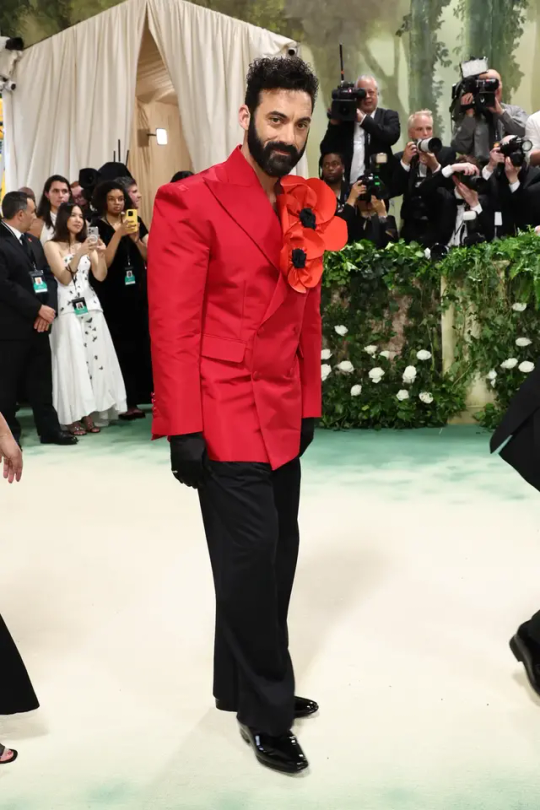


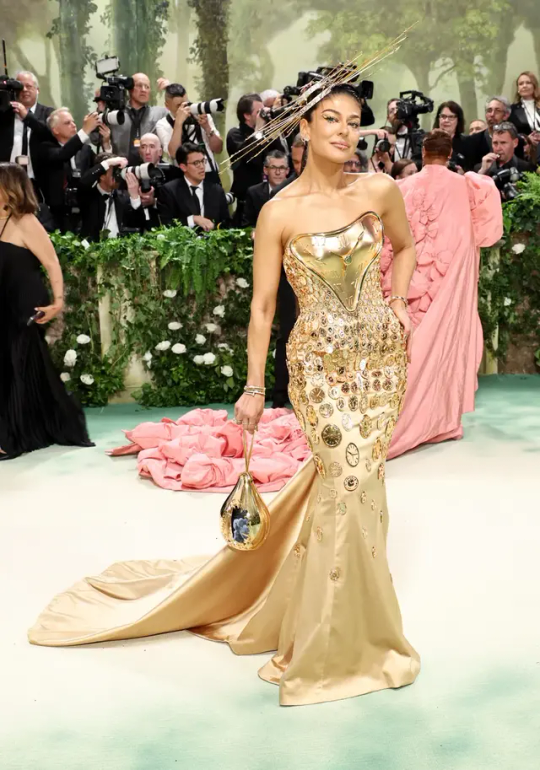
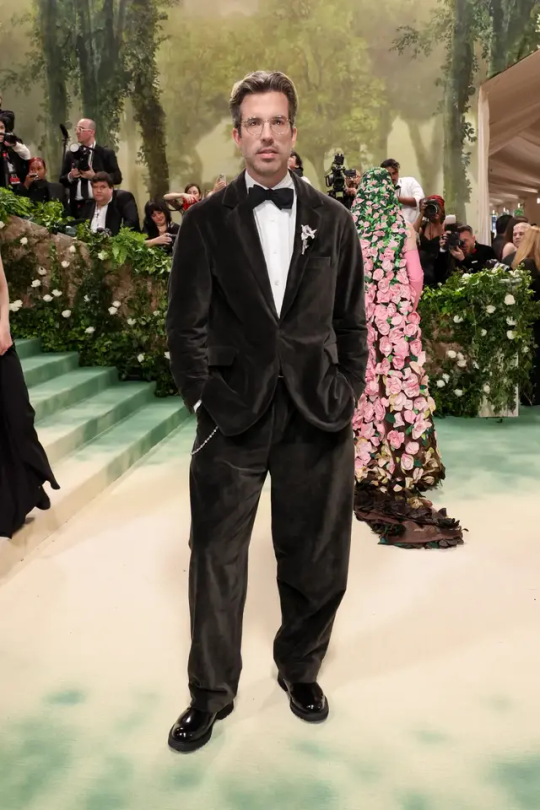
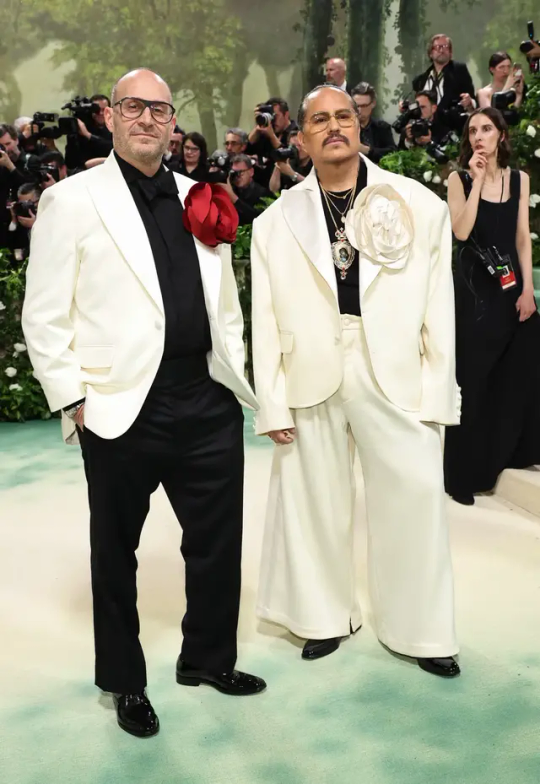
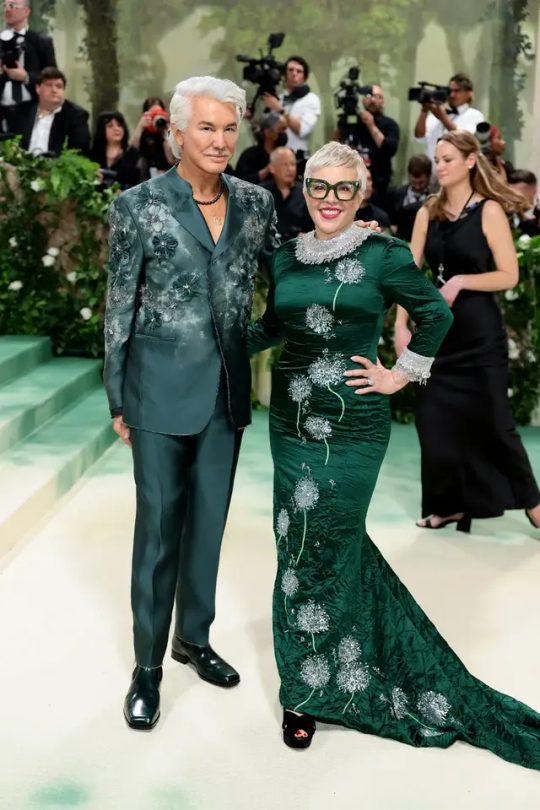
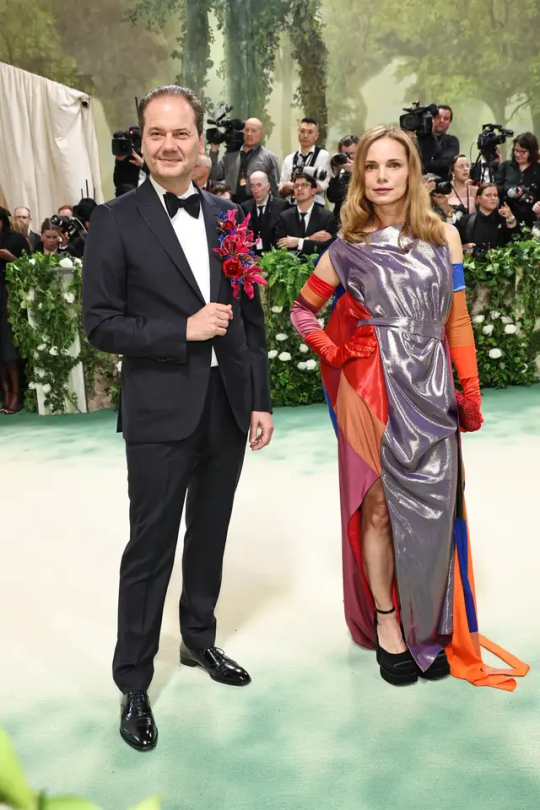



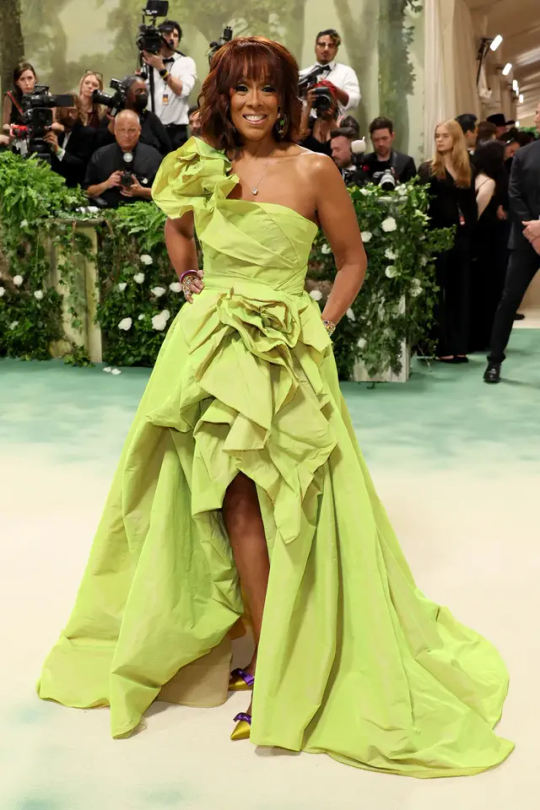


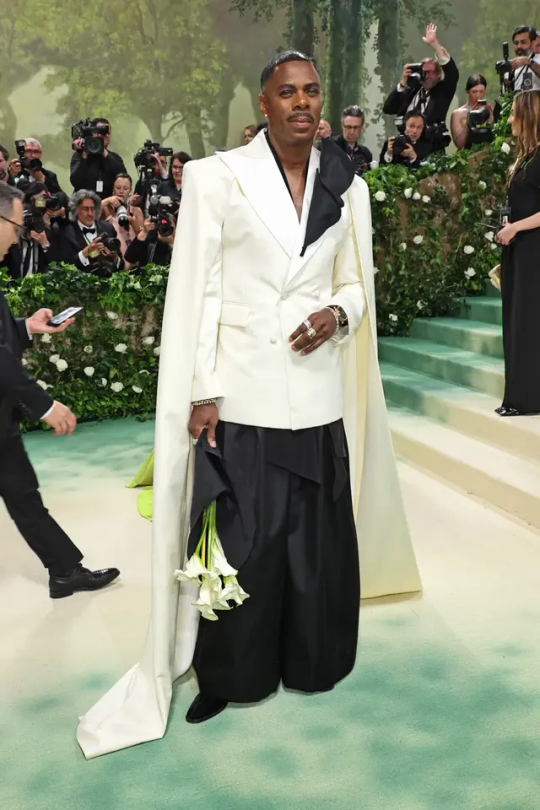
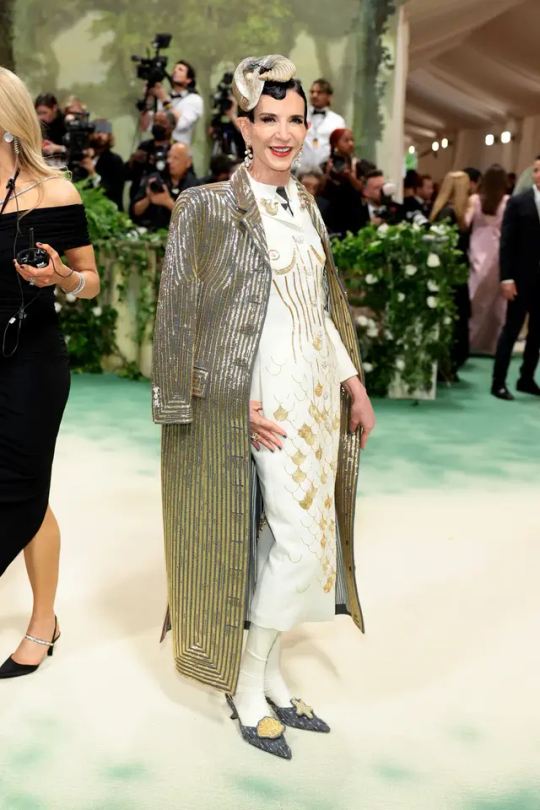
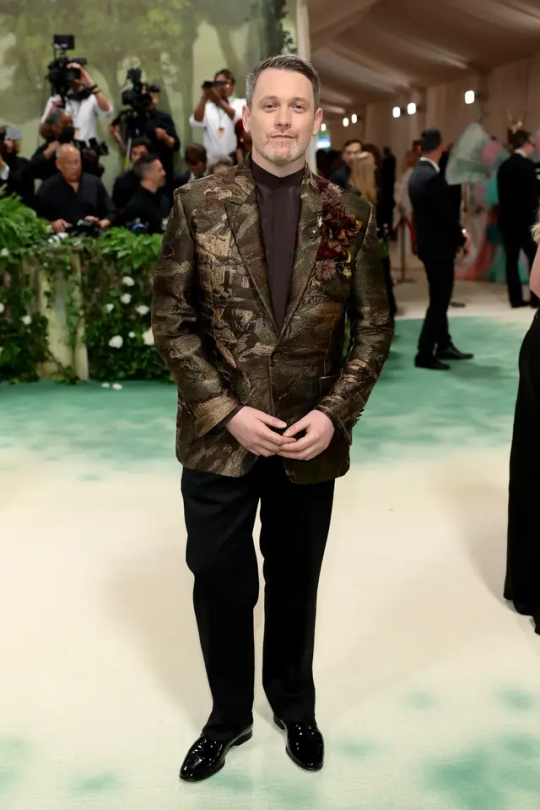
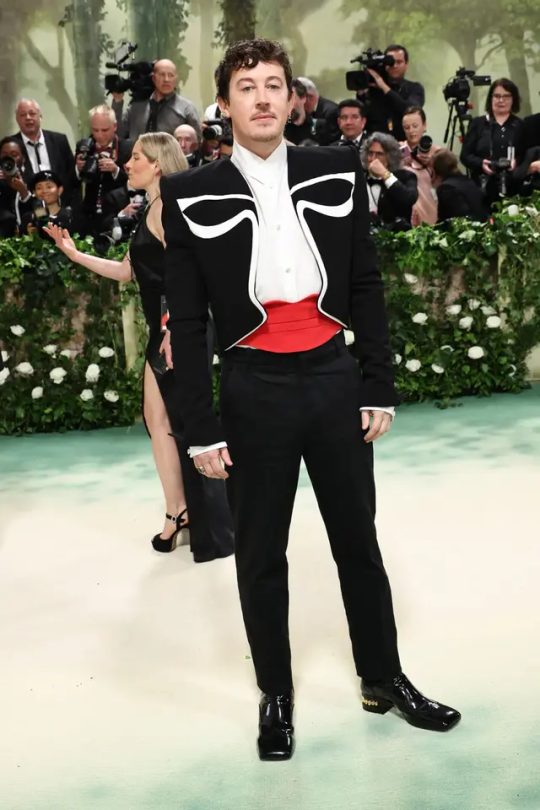

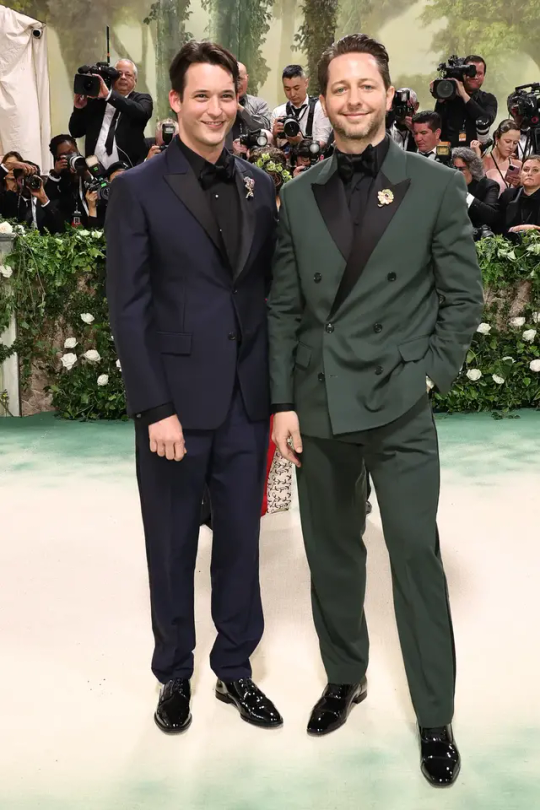
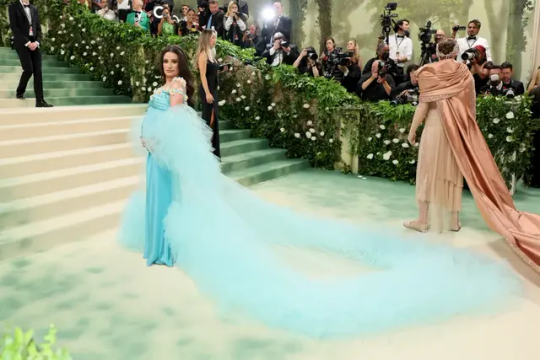
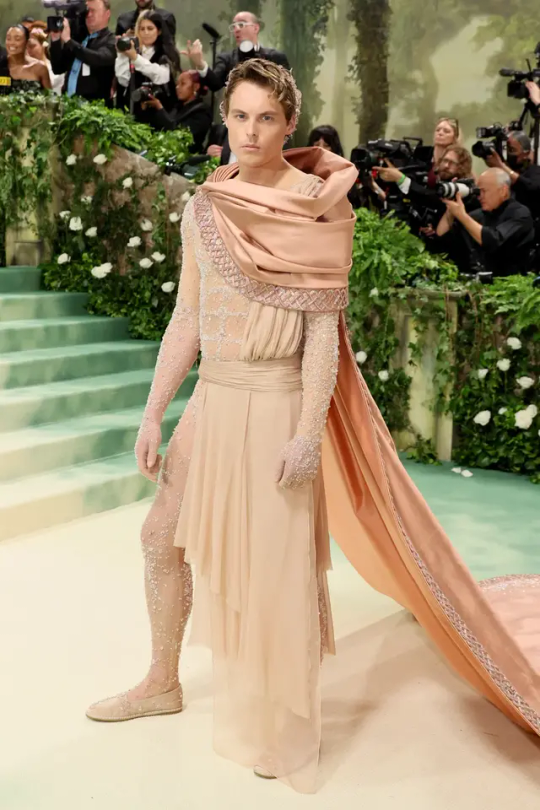
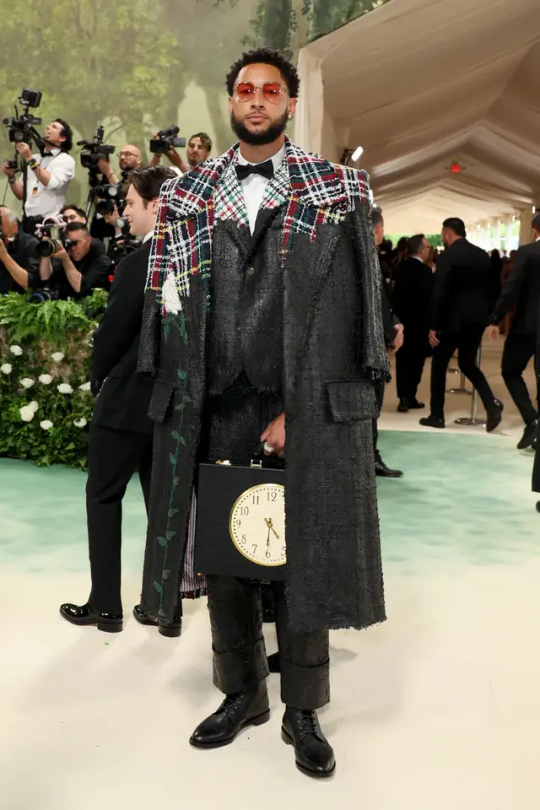



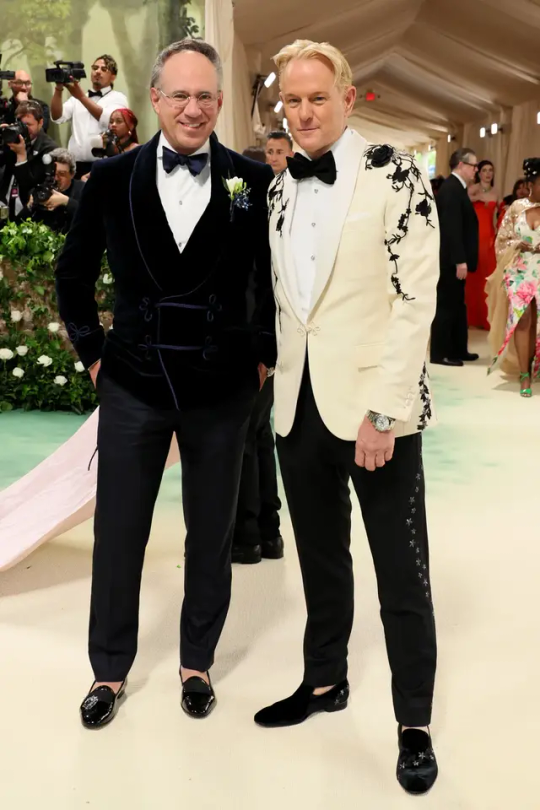

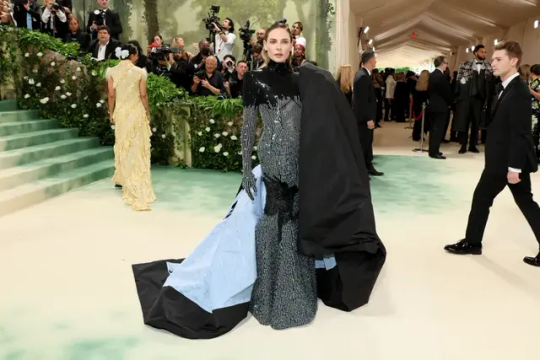
MET Gala 2024, "The Garden of Time"
#met gala#the met gala#met gala 2024#nell diamond#andrew saffir#daniel benedict#rebecca ferguson#jonathan groff#chioma nnadi#ben simmons#maleah joi moon#steve newhouse#gina sanders#gustav magnar witzoe#lea michele#nick brown#derek blasberg#cole escola#alex sharp#michael arden#amy fine collins#colman domingo#gayle king#emma mackey#jamie singer soros#robert soros#rebecca hall#madelyn cline#max hollein#nina hollein
51 notes
·
View notes
Text
I’m writing a compendium of Cruise Teller characters together all linked by the theme of breeding because well, why not 😅
There’s Stacee (Rock of Ages) and Andrew (Whiplash)
Ray (War of the Worlds) and Jason (Rabbit Hole)
Danny (A Few Good Men) and Adam (Thank you for your service)
David (Vanilla Sky) and Dave (War Dogs)
Frank (Magnolia) and Al (The Offer)
I might add more once but who knows.
Anyway if you fancy reading so smut with some fluff and angst, then it’s called Breed Me Good.
#CTCU#tom cruise#miles teller#stacee jaxx#andrew neiman#ray ferrier#Jason rabbit hole#daniel kaffee#Adam Schumann#David Aames#David Packouz#Frank T J Mackey#Al Ruddy#rock of ages#whiplash#war of the worlds#rabbit hole#a few good men#thank you for your service#vanilla sky#war dogs#magnolia#the offer#my fics
44 notes
·
View notes
Text

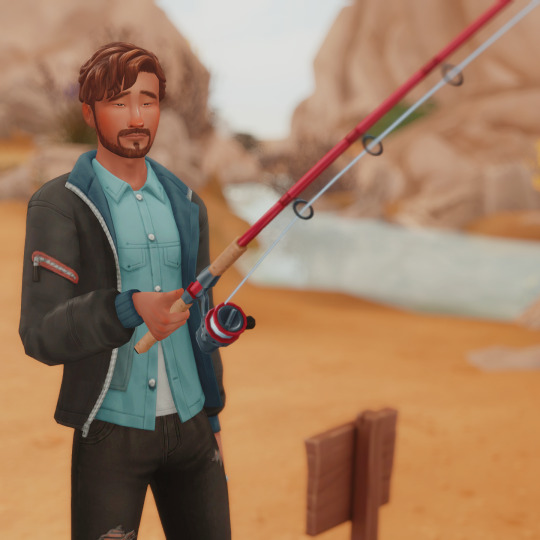

12 notes
·
View notes
Text
Okay folks, listen up. My friend and I (mostly I) started casting people for If We Were Villains. Long story short I got obsessed and couldn't stop till I found the perfect cast. And now that I have found them (a british cast for an American production because why not?), I am here to scream it into this corner of the world.
Lo and behold:
Oliver - Josh O'Connor
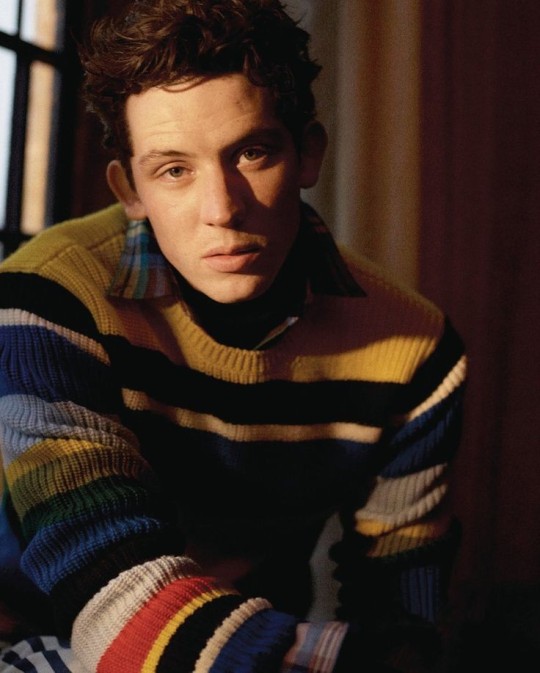
James - Nicholas Galitzine

Richard - Kedar Williams-Stirling
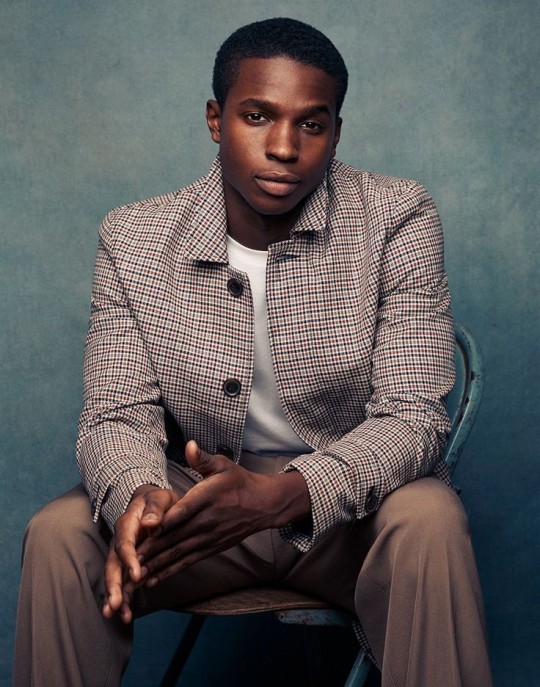
Alexander - Miguel Herrán

Wren - India Ria Amarteifo

Filippa - Emma Mackey

Meredith - Danielle Galligan

Yes, now I would like us all to collectively manifest this casting to fruition..
P. S. Why was it so damn hard to find a Hispanic-British actor under 30s, who could pull of the nonchalant druggie who is everyone's and no one's best friend?
P. P. S. Robert Sheehan from Misfits days would have been my ideal choice for Alexander though.
#if we were villains#if we were villains casting#tumblr casting#tumblr cast#danielle galligan#josh oconnor#nicholas galitzine#kedar williams stirling#emma mackey#india amarteifio#miguel herran#m l rio#please make this happen#i would combust if they make a show for the book
6 notes
·
View notes
Note
Thanks re Gelphie timeline ask. I hope I'm not pestering but what are these queerest boots. I've been trying to catch up on fifteen years of the show since the movie came out abd it's been this weird whipsaw between "nope don't see it" and "these two are so in love you'd have to be blind not to see it."

CERTAINLY YOU ARE NOT PESTERING ME THIS IS LITERALLY ALL I THINK ABOUT THESE DAYS <3
just in case you haven't seen it, i will first direct you to my Ozcars post in which I gave many awards trying to categorize these things
SO rather than do this in pairs because that's what i did last time, I think this time I will go by singletons
Glindas Who Always Do It Gay, You Can Set Your Watch To It:
Katie Rose Clarke
Annaleigh Ashford
Ginna Claire Mason
Gina Beck
Glindas Who Do It Pretty Dang Gay Most Of The Time
Kara Lindsay
Carrie St. Louis
Glindas For Whom More Data Needed On My End To Know Baseline Gayness But Signs Are Good
McKenzie Kurtz
Glindas Who Did it Gay ONCE and it Haunts Me
Brittney Johnson (Sep 2019)
Erin Mackey (Feb 2007)
I Don't Know How To Explain Kendra Kassebaum So She's Her Own Category
KENDRA KASSEBAUM
I feel weird leaving Austen Danielle Bohmer off this list but like. FEEL FREE TO PROVE ME WRONG AUSTEN, MASTERS FEEL FREE TO MAKE MANY MORE CONTEMPORARY BOOTS RN SO I HAVE MORE DATA. but to my personal taste, her Glinda is palpably queer and definitely loves Elphaba but doesn't really... Give Gelphie? idk how to explain it
I'd make a corresponding list of Elphabas, but in many ways I think that is less useful and informative. MOST elphies are receptive and reflect it back when their Glinda's giving heart eyes, and the Glindas who give heart eyes are listed above. to separately give you a list of Elphies who were THEMSELVES giving heart eyes and did not have a Glinda who could carry the other half is. kind of a bummer of a list. if the goal is to find boots where you can See The Love, I'd definitely start with these ones and then go to the ones that are wonderful but entirely platonic (Megan Hilty, Hayley Podschun, Sarah Jane Shanks to name a few) before you go to the ones make you want to tear your hair out because the Elphaba deserves so much MORE and either never got or wasn't recorded with a Gay Glinda
it's Nicole Parker and Christine Dwyer
also possibly Lissa de Guzman but i need more data to be sure Jennafer CAN'T give gay; I Want To Believe
anyway YES ALWAYS ASK ME MORE QUESTIONS I LOVE THE QUESTIONS
17 notes
·
View notes
Note
Thank you so much for raising awareness for Palestine <3 Can I please ask for some female faceclaims preferably around 21-30 who have resources that have witchy vibes and would fit into a modern supernatural setting, please? Thank you so much!! 🍉
Davika Hoorne (1992) Thai / White.
Devery Jacobs (1993) Mohawk - is queer - has spoken up for Palestine!
Raveena Aurora (1993) Punjabi Indian - is pansexual - has spoken up for Palestine!
Jordan Alexander (1993) African-American and White - is queer - has spoken up for Palestine!
Mia Khalifa (1993) Lebanese - has spoken up for Palestine!
Mina El Hammani (1993) Moroccan - has spoken up for Palestine!
Natasha Liu Bordizzo (1994) Chinese / White.
Aurora Perrineau (1994) Black and White.
Lily Sullivan (1994)
Khadijha Red Thunder (1994) Cree, African-American, Spanish.
Jaz Sinclair (1994) African-American / White.
Dylan Gelula (1994) Ashkenazi Jewish / Unspecified - has spoken up for Palestine!
Jessie Mei Li (1995) Hongkonger / English - is a gender non-conforming woman who uses she/they - has spoken up for Palestine!
Lulu Antariksa (1995) Indonesian / White.
Benedetta Gargari (1995)
Ryan Destiny (1995) African-American, 1/4 White.
Juliette Motamed (1995) Iranian - has spoken up for Palestine!
Adeline Rudolph (1995) Korean / White.
AURORA (1996) - has spoken up for Palestine!
Emma Mackey (1996)
Lorde (1996) - has spoken up for Palestine!
Tati Gabrielle (1996) African-American, ¼ Korean.
Joy Sunday (1996) Nigerian.
Brittany O'Grady (1996) Louisiana Creole [African, French] / White.
Mollie Gallagher (1997)
Nicole Maines (1997) - trans.
Antonia Gentry (1997) Afro Jamaican / White.
Blair Lamora (1997) Ojibwe / Argentinian - is bisexual.
Valentina Zenere (1997) Argentinian.
Havana Rose Liu (1997) Chinese / White.
Kiana Ledé (1997) African-American, Swedish, Mexican, is also Cherokee and Unspecified Indigenous but I don’t know if this is verified or documented - has spoken up for Palestine!
Brianne Tju (1998) Chinese / Indonesian.
Erin Kellyman (1998) Afro Jamaican / White - is a lesbian.
Lauren Tsai (1998) Taiwanese / White.
Ayesha Madon (1998) Indian.
Alva Bratt (1998)
Ethel Cain (1998) - is a trans bisexual and autistic woman - has spoken up for Palestine!
Jessica Alexander (1999) - has spoken up for Palestine!
Lizeth Selene (1999) Mexican [Black, Unspecified Indigenous, White] - is genderfluid and queer (they/she).
Kenna Sharp (1999) - is queer - has spoken up for Palestine!
Noor Taher (1999) Palestinian / Lebanese.
Lisette Olivera (1999) Mexican.
Mikey Madison (1999) part Ashkenazi Jewish.
Danielle Rose Russell (1999)
Towa Bird (1999) Filipino and White - is queer - has spoken up for Palestine!
Odessa A'zion (2000) Ashkenazi Jewish, English, some Irish, Northern Irish, Welsh, German - has spoken up for Palestine!
India Amarteifio (2001) Ghanaian / White - has spoken up for Palestine!
Freya Allan (2001) - has spoken up for Palestine!
Azul Guaita (2001) Mexican.
Rhea Norwood (2001) - has type 1 diabetes - has spoken up for Palestine!
Jenna Ortega (2002) Mexican and Puerto Rican - has spoken up for Palestine!
I hope this helps! I have listed Jewish faceclaims but please be mindful not to use any antisemitic rhetoric, you can read more HERE.
8 notes
·
View notes
Text
Hellhounds on His Trail: E L U C I D's REVELATOR

I speak what I see.
—Saul Williams, “Elohim (1972)” (1998)
I say that one must be a seer, make oneself a seer. The poet makes himself a seer by a long, prodigious, and systematic derangement of all the senses.
—Arthur Rimbaud, “Letters of the Seer” (1871)
Every technological change begins with a spiritual revelation.
—Nathaniel Mackey (2016)
1. LASCIATE OGNI SPERANZA, VOI CH’ENTRATE
The same motherfucker got us living in his hell.
—Chuck D, Public Enemy’s “Black Steel in the Hour of Chaos” (1988)
I must forewarn you even now: what I intend to speak about, and in which I shall get myself entangled for reasons more serious than my incompetence, they are, I believe, without solution or exit. Two years ago, ELUCID promised that I Told Bessie could be significantly darker: “Trust me, it could be way more apocalyptic.” REVELATOR fulfills that promise. I Told Bessie introduced ELUCID as an anti-mystic mystic; on REVELATOR, we find him between the forge and the flame. He speaks from filthy tongue of god and griot, offering a <brand> of spiritual healing in the same <vein> as Dälek’s “Spiritual Healing” [for brand read “fire,” “cauterize,” “marked ownership”; for vein read “cold,” “spike,” “artery”]. At turns, his speech sounds of languages diverse, horrible dialects, accents of anger, words of agony, and voices high and hoarse. On ITB, ELUCID had just arrived in Heaven, trespassed its gates, yet stubbornly refused to sit down, to repose. On REVELATOR, he’s at Hell’s wrought-iron threshold, absolutely ruptured.
ELUCID emerges as a transgressive and dark magus speaking the omniversal language of Sun Ra. The first words spoken on REVELATOR, evidently ad-libbed, recall both Fritz Lang’s expressionistic Tower of Babel and Mister X’s psychitecture: “Metropolis…inverse overlord skyscape…” Another filmic nod would be to PTA’s There Will Be Blood (2017), where the climactic and classical rage of Daniel Plainview is unleashed as he screams: I am the Third Revelation! Plainview is, as his name intimates, an unbeliever, and he masterfully coerces preacher Eli Sunday into stating he’s a false prophet and that God is a superstition.
See, the First Revelation was in the Old Testament (Show me your commaaaandments, as ELUCID drones on “Barbarians”); the Second Revelation was Jesus sermonizing that new shit; why mightn’t it be that the Holy Spirit was preparing another? ELUCID delivers the Third Revelation; he is the Seer, the Revelator—entering through a hatch [re: portal] of Houston horrorcore and disharmonic hard bop. REVELATOR is his unexpurgated rendition of K-Rino’s Stories from the Black Book (1993). The mutant blues of ITB have turned to hypnotik hip-noize—serrated, jaggy, shrapKnel-shattered, caltrop-piercéd. We witness, firsthand, the doom gospel he has previously preached about in practice, in praxis, in the demoniac rhythms and the patterns. Ganksta N-I-P’s “Reporter From Hell” (1993) amalgamated with Rimbaud’s A Season in Hell (1873).
2. NOISOME THE EARTH IS
“Here in this hymn-deaf hell,” Rimbaud reports back, but in ELUCID’s hell all we hear are hymns—shrieks, semiwept, semisung. “A black wail is a killer,” Tracie Morris, Harryette Mullen, Jo Stewart, and Yolanda Wisher write in “4 Telling” (2021), a posse-cut poem. Production of “a satanic symphony,” Rimbaud says. Sounding like EPMD in the pulpit, Rimbaud claims “[t]heology is serious business: hell is absolutely down below.” He describes moonlight when the clock strikes twelve, “the hour when the devil waits at the belfry.” Go get a late pass, in other words, as PE presses on “Countdown to Armageddon” (1988) and ELUCID reiterates on “MBTTS” (2016). “Watch me tear a few terrible leaves from my book of the damned,” Rimbaud writes, appealing to the Devil, “...I will unveil every mystery.”
ELUCID unveils histories of mysteries during his descent. On record, he shares what he sees. He sees Rimbaud in Hell. He sees Kanye and JPEGMafia in hell, Ye with BURZUM in Gothic script emblazoned across his chest. He sees Rubble Kings with SS skulls and sigs sewn onto Flyin’ Cut Sleeves denim. He sees Black Benjie’s assassin in Hell. He sees Richard Hell in hell holding White Noise Supremacists to account for how they treated Ivan Julian (“Mutants can learn to hate each other and have prejudices too,” the latter told Lester Bangs). He says peace to SKECH185 and sees him “playing devil’s advocate with Steve Albini’s Black friend.” Finally, he sees the cerberus in hell—the “monster cruel and uncouth,” according to Dante (c. 1321)—the 3-headed anti-crowd dog. He sees its three gullets, red eyes, and unctuous beard and black and belly large. He sees the wretched reprobates. He sees muzzles filth-begrimed. He sees hellhounds here, there, and everywhere.
3. ROUND US BARK THE MAD AND HUNGRY DOGS
From forth the kennel of thy womb hath crept A hellhound that doth hunt us all to death—
—Shakespeare, Richard III, 4.4.49-50 (c. 1592-1594)
“Hands off,” ELUCID commands on “THE WORLD IS DOG,” the opening salvo on REVELATOR [salvo, a discharge of weaponry; yet also salivate: dog’s drool, secretion, spittle, spit the verse]. “It’s just happening,” he shouts—it’s happening to us; we are subjects of history, its malevolent thrum. “I can feel it ’fore you say it,” and I’ve no reason to doubt him. But allow me to litanize anyway.
In Afro-Dog: Blackness and the Animal Question (2018), Bénédicte Boisseron writes that the dog, the canis familiaris, is “an unwilling participant in the history of social injustice,” a casualty to a depraved Pavlovian conditioning. She cites an “association between canine aggression and black civil disobedience,” reflecting a “prism in which race and dogs insidiously intersect in tales of violence.” She refers to these as cyno-racial (dog-black) representations.

Bloodhounds—aptly-named barking, beastly embodiments of biopower—were “imported from Cuba or Germany” during slavery and “trained to pursue escaping slaves in both the Caribbean and the American South,” Boisseron writes. Dogs were designed to “become ferocious only when in contact with blacks.” The Narrative of James Williams, an American Slave, Who Was for Several Years a Driver on a Cotton Plantation in Alabama (1838) provides insight into this odious operation:
A negro is directed to go into the woods and secure himself upon a tree. When sufficient time has elapsed for doing this, the hound is put upon his track. The blacks are compelled to worry them until they make them their implacable enemies; and it is common to meet with dogs which will take no notice of whites, though entire strangers, but will suffer no blacks.
The Narrative of the Life and Adventures of Henry Bibb, an American Slave, Written by Himself (1849), meanwhile, offers a suspenseful, first-person account:
We had been wandering about through the cane brakes, bushes, and briers, for several days, when we heard the yelping of blood hounds, a great way off, but they seemed to come nearer and nearer to us. We thought after awhile that they must be on our track; we listened attentively at the approach. We knew it was no use for us to undertake to escape from them, and as they drew nigh, we heard the voice of a man hissing on the dogs.… The shrill yelling of the savage blood hounds as they drew nigh made the woods echo.
The training, of course, isn’t only about ghoulish intimidation; the hunt would often climax with violence. “When the slave runs away,” Boisseron explains, “the master needs to symbolically reassert his domination through a ritualized act of flesh cutting.” [FANG BITE!] Frederick Douglass spoke of such savagery: “Sometimes in hunting negroes…the slaves are torn to pieces.” Mutilation of runaway slaves, Boisseron claims, enacted “a rhetoric of edibility.” Derrida called it carno-phallogocentrism, linking the slavehunter’s virility and carnivorism, savoring “deeper shades of carnage,” as ELUCID says on “ZIGZAGZIG.” It has never relented. In the wake of Michael Brown’s murder in 2014, the DOJ issued a report that detailed “puncture wounds” left in children by the Ferguson K-9 unit. The victims of these “bite incident[s]” were always Black.
ELUCID also speaks of how victims “force-feed a war machine” on “ZIGZAGZIG”—regions and relics swallowed whole, irrevocably. In their plateau “Becoming-Intense, Becoming-Animal, Becoming-Imperceptible…” (1980), Deleuze and Guattari write: “You become animal only molecularly. You do not become a barking molar dog, but by barking, if it is done with enough feeling, with enough necessity and composition, you emit a molecular dog.” Somewhere on a desolate Yonkers street corner, DMX sleeps with a pack of strays, lying in wait.

4.
Police forces…have used dogs to break up rioting mobs…. The dogs’ snapping teeth, swift movements and indifference to the crowds’ menacing threats have made mob control a routine procedure for the forces which have the dogs.
—“A Progress Report of the Assembly Interim Committee on Governmental Efficiency and Economy on Using Dogs in Police Work, California” (1960)
If a dog is biting a black man, the black man should kill the dog, whether the dog is a police dog or a hound dog or any kind of dog… [T]hat black man should kill that dog or any two-legged dog who sicks the dog on him.
—Malcolm X (1963)
In a contemptible case of cultural exchange, two German shepherds trained by a Nazi stormtrooper were used by police in Jackson, Mississippi to attack crowds in support of the Tougaloo Nine—Black students attempting to access books from a whites-only public library. That was in 1961. [TRUST NONE!] Two years later, Bull Connor utilized dogs to disperse protestors in Birmingham, notoriously documented by Charles Moore and Bill Hudson. Hudson’s photograph of fifteen-year-old Walter Gadsden in the mongrel maw of law enforcement fills textbook pages to this day, while Moore’s photo would be aestheticized and reproduced in Andy Warhol’s Race Riots series in 1964. “Police dogs is one of the accepted practices in police riot work,” a swinish Alabama sheriff said in ’63. Not much has changed. When people demonstrated outside the White House gates after the death of George Floyd, an orange fascist—who ELUCID begrudgingly won two long-standing bets on—threatened them with “vicious dogs.”

“Dogs were once perceived as dangerous due to rabies,” Boisseron writes, “but today the black man is the one responsible for making the big dog look ‘un-kind.’” A.G. rapped about the dogs with the rabies on 1992’s “Runaway Slave,” looking backward to understand his present, but by the ’90s, the ever-evil LAPD was calling Black people “dog biscuits.” An officer in a St. Louis suburb faced suspension after posting to Facebook that Ferguson protestors “should have been put down like a rabid dog the first night.” The aggression of the dogs, Boisseron points out, has “metonymically shifted from zoonotic to a racial context.” In essence, society shouldn’t fear the dogs—society should fear a Black planet populated by Black men. [FEAR ALL!]
The messaging has frequently been mixed—deliberately muddied (mutted, we might say) to defy understanding—racism skewing absurdist. In “A Dark Brown Dog” (1901), Stephen Crane used a “little dark-brown dog…an unimportant dog, with no value” with a “short rope…dragging from his neck” for allegorical purposes. [SHORT LEASH!] A child drags the dog “toward a grim unknown,” the child’s intolerant family. The dog is by its very nature powerless, “too much of a dog to try to look to be a martyr or to plot revenge.” Eventually, the drunk father beats the dog with a coffee pot and tosses him out of a fifth-floor window, falling dead in the alley below. Crane’s well-meaning story speaks to mystery writer Stanley Ellin’s comparison of the “solicitous white intellectual” and the “arrant racist,” the former of which “sentimentalized Black lives” and “patted them on the head as one would a pet spaniel.” To retreat to such romanticizing, Ellin says, fulfills the “function of the stereotype, and it matters very little whether the stereotype is that of vicious hound or pet poodle.”
As a child of the ’80s, ELUCID was exposed to the same surfeit of televised copaganda as the rest of us. McGruff the Crime Dog colonized our commercial breaks, asking us to join the feeding frenzy against drug dealers and burglars (Take a bite out of crime!). Meanwhile, Harlem World’s Herb McGruff provided counterprogramming and warned us of the real “Dangerzone.” “The idea of dogs attacking black people has become a haunting and unresolved image in the collective memory,” Boisseron writes, or, in ELUCID’s words: Eating everyone eventually. THE WORLD IS DOG!

5.
On SEERSHIP! (2020), a project ELUCID labeled a “work of spirit”—a work of glitch-hop and runt pulses and ill-bent illbient—we hear a blare of noise at roughly the one-minute mark. That calamitous blare is sublimated into the soundfury that sets off “THE WORLD IS DOG.” ELUCID’s bogeyman-down production, in collaboration with Jon Nellen’s urgent drumming and Luke Stewart’s grave-groove bass theories, provide for the sonics of a slave escape, equal parts panic and empowerment. “The dissonance is real,” ELUCID raps on “VOICE 2 SKULL,” “—I be feeling woozy,” and that’s the vibration here. In Dred: A Tale of the Great Dismal Swamp (1865), Harriet Beecher Stowe describes how the vengeful and unforgiving escaped slave Dred defends a runaway from a hellhound:
…a party of negro-hunters, with dogs and guns, had chased this man, who, on this day, had unfortunately ventured out of his concealment. He succeeded in outrunning all but one dog, which sprang up, and, fastening his fangs in his throat, laid him prostrate within a few paces of his retreat. Dred came up in time to kill the dog…
“THE WORLD IS DOG” is pulsing and gnashing, a sequence of switchbacks and untoggled kill switches, a hyper-aural freak-out, to borrow some phrases from ELUCID’s New York Times blurb for Ornette Coleman’s “Science Fiction.” We should’ve anticipated the arrival of “THE WORLD IS DOG,” should’ve been listening to the panting precursor curses. Be it the gold chain punk asphyxiation of Soul Glo opening for ELUCID at the ITB release show at Mercury Lounge in 2022; the absurd matter we heard from his Shapednoise feature in 2023, wherein he “backhoed the graves”; or his appearance on Kofi Flexxx’s “Show Me” a few months later (I show you what it look like…)—the signs were all there. When word got out that ELUCID was spinning Miles Davis’s “Rated X” (1974), we should’ve known it was over, cataclysmically.
If “Rated X” is the model, then ELUCID has set out to attain “music’s most elusive grail,” as Gary Giddins calls it in Visions of Jazz (1998): “the promise…of an open-ended form that defies harmonic conventions and regulation eight- and twelve-bar phrases in favor of a flexible but contained form.” An anonymous internet blogger called “Rated X” a “demented church service where the organist has become possessed by an evil spirit and worshippers have fallen into a trance.” ELUCID puts the incendiary fuse in fusion—dark energy acceleration | emergent fervor, fire & brimstone | Tony Williams Lifetime-type EMERGENCIES [ecphoneme—bang—ecphoneme—bang…]. This is rap-fusion—uncontrived, channel alive.

6.
“Fire for fire, wade in the water,” ELUCID raps on “YOTTABYTE,” singing the same sorrow song of a century-plus before. “Wade in the Water” (Roud 5439) was a spiritual that reminded the runaway slaves to use streams and rivers to throw the hellhounds off the scent. “If you hear the dogs,” Harriet Tubman said, “keep going.” If “THE WORLD IS DOG” begins in a dreaded delirium, it ends [DEVOLVE!] in radical resistance.
The faded amateur photograph that graces the cover of I Told Bessie shows a man fending off a German shepherd; or, feasibly, the man is elevating the dog—healing it, calming it, exorcizing its engrained demons. Admittedly, it’s a crazy mixed-up world, a doggy dogg [dog-eat-dog] world, and the dog can occupy valences of both killer and companion. Everyone is dehumanized in the slave hunt, in the crowd dispersal. The hunters and the cops are the actual beasts (“That’s the sound of da beast,” KRS howls; “the murderous, cowardly pack,” Claude McKay snaps); the hunted resort to instinct, fearing for their lives, amygdala swelling with signals.
In Martin Delaney’s serialized novel Blake; or, the Huts of America (1859-1862), protagonist Henry Holland, a.k.a. Blacus, a.k.a. Blake, wields a “well-aimed weapon” and “slew each ferocious beast as it approached him, leaving them weltering in their own blood instead of feasting on his.” Delaney doesn’t only draw scenes of retributive slaughter; his characters also speak of how “da black folks charm de dogs.” Threats neutralized. Power harnessed. The Yorkshire Terrier on the cover of Swans’ The Seer (2012) bares Michael Gira’s chompers—he’s merged with the pup. Hip-hop auto-interpellated dog into dawg (s/o to Althusser).
7.
As we learn from “Amager,” ØKSE’s song featuring billy woods, dogs only violate at the behest of men. woods relates a narrative of detainment at Trondheim Airport. The purportedly “colorblind drug dog” exudes innocence (“flopped on the floor, head on his paws”), though its mere presence smacks of discipline and punishment. As the Norwegian customs agent “palm[s] [woods’] clean drawers,” woods sardonically reflects, “I been a nigga too long.” He “know[s] the dance” and “know[s] the damn song,” resentful of this choreography of incurable racism that has been all too common and recurring throughout his life. He understands what’s happening epistemologically (“I know they hoping… I know I’m clean…”), but he also knows “those clammy hands going from the crack of [his] ass to the weight of [his] balls” are suggestive of castration, and when you’re crossing borders, what, what, say what, say what, anything can happen. As they go through the rigamarole of “mak[ing] calls, x-ray[ing] the empty suitcase, / [And] going back through [his] pockets,” woods stews with “impotent rage,” the aforementioned emasculation working its spell. He doesn’t begrudge the animal laboring under the aegis of the Tolletaten, though: I pet the dog as I leave. Scathed but saved. He charmed de dog.

8.
After dealing with so many strays I had learned one thing: be patient.
—E.A.R.L.: The Autobiography of DMX (2003)
Perhaps no figure better illustrates the subjugation and subversion of the hellhound than DMX. In the lead up to the millennium, Dark Man X embodied the dog of vengeance; he exemplified the undoing of the dog’s quasi-innate hatred of Blackness. In ELUCID’s words, he emerged as a “whole new nigga” with “skin [untorn], eyes [ungouged], hair [unshorn].” DMX’s arrival in 1998 felt like centuries in the making. He waged a vendetta in the name of every runaway slave and Civil Rights demonstrator. He’d slept on the streets and shared the concrete with his dogs, strays like himself:
Stray dogs are normally scared of people; they’re scarred by whatever neglect or abuse put them out on the street. Or if they’re lost, they’re depressed because they can’t find their way home. But that morning I decided that no matter how long it took, I was going to get that dog to come over to me. I was going to convince him to trust me and make him mine…. I started looking all over for strays that I could catch and train for myself…
DMX charmed de dogs and the rest of us in the process. He stayed shitty, cruddy, trading the cartoonish bow-wows we’d become accustomed to (via Snoop) for fierce grrrs and arfs, elevating rap’s onomatopoeics. With “Get At Me Dog,” he turned a familiar B.T. Express funk sample feral. In the video, the most achromatic Hype Williams ever managed, X holds possession of the Tunnel crowd, on a stage but of the people. His only bling: a stainless steel choke chain that collars his neck. The black-and-white video disorients with strobe effect and negative exposure—pitch blacks suddenly transform into flashing whites. Russell Simmons and Lyor Cohen look on from the periphery of the crowd like, well, out-of-place bitches. The video captures the raw power of DMX, his stygian intensity, reminiscent of Tadayuki Naitoh’s 1971 photograph of Miles Davis. Like X, Davis harnesses his rancor and exhibits his self-possession.
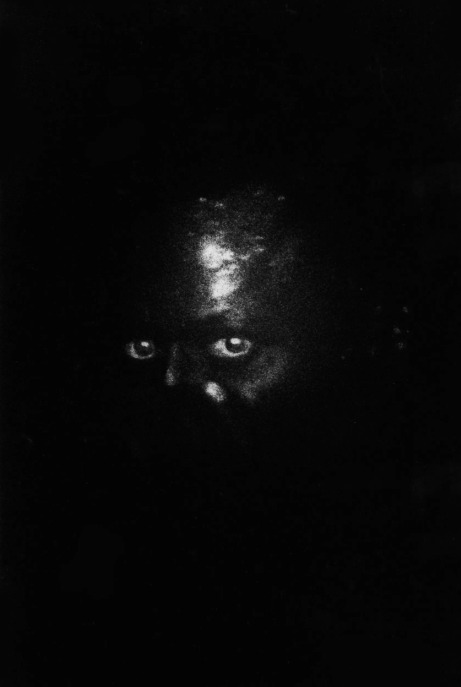
The success of DMX’s subversion of the dog trope likely apexed with his Woodstock ’99 performance. Before a majority white crowd of hyperthermic slavehunter descendants, DMX rocked what Thomas Hobbs calls “blood-red dungarees.” X “growls viscerally” and “convulses” across the stage in a manner “akin to a Bad Brains gig in a sweaty punk basement.” DMX—like Dred and Blacus before him, like ELUCID to come—subdues the monstrous, cowardly pack, and has them eating Milkbones out of his hand by the end of the 45-minute set.
9.
The first thing we feel on REVELATOR is a snarling, ravenous “fang bite” and the exhale of “dog breath.” We search for alternatives: the RZArector’s fangs on 6 Feet Deep (1994) maybe, a presence that Kodwo Eshun argues is akin to a head “filled with revelations that impeach the daylight.” We might think of the parallel universe of “The Big Rock Candy Mountains” (1928) where “dogs all have rubber teeth,” but REVELATOR doesn’t offer up that heavenscape—only a hellscape where teeth tear rabidly, rapidly. The “dog fangs [which dig] into black flesh,” Boisseron writes, are “deeply ingrained in popular culture.” We’d prefer the hip-hop context for “biting,” like when Rakim invokes “biting and borrowing” on “Follow the Leader,” where “brothers tried and others died to get the formula.” We’re on a “short leash” here, but Chuck D speaks of how he “cut the leash” on “Black Steel in the Hour of Chaos” and how prison bars “got [him] thinking like an animal,” and so I think we should act accordingly, tactfully, and lick our wounds.
ELUCID strafes us with 2-syllable units, iambs or IEDs, right from the start:
Fang bite Dog breath Short leash Pit fight
We’ve not felt shelling like this since the opening words of DMX’s It’s Dark and Hell Is Hot (1998):
One-two One-two Come through Run through Gun who? Oh, you don’t know what the gun do?
We’re propelled and pummeled by a Dark Enlightenment acceleration; unquestionably, we’re on our heels. ELUCID activates a sequence of 3-syllable units—anapests—as we descend into Hell:
From this height At this speed Downhill Careening
Later, the 2- and 3-syllable units alternate: “Shit that binds, / Spit out, / Ribs came spared.” Such blunt syllabics occur elsewhere on the album as well. “YOTTABYTE,” for instance, introduces a more dactylic, grounded pattern: “Hard science, / Scum gutter.” These are billboard throw-ups in Mister X’s Radiant City. They’re terse skull snaps like when Michael Gira sings, “Space cunt, / Brainwash” on “The Apostate.”
“I’m not psychic, but I’m reading,” ELUCID clamor-raps. The rapper has repeatedly denied the spiritual and supernatural in favor of tangible work, learning, reading. He much rather attend a demo or browse a bookstore than show his face at a séance or a church service. “The more I thought, the less I prayed,” he raps on “BAD POLLEN.” In this regard, he’s a dialectical materialist, much to the dismay of so many nimrod New Age seekers. ELUCID is not your self-help savior. Appropriating occult symbology in song is not inscribing sigils on the navel of a newborn. More likely he’s standing in solidarity with the child laborers pulling opal from the ochre mines of Madagascar. “Black Jesus hated bill collectors—I do the same,” he raps on “IN THE SHADOW OF IF.”
In The Conjure-Man Dies (1932), Rudolph Fisher’s Harlem murder mystery, the titular conjure-man, one N’Gana Frimbo, is the closest forebear to ELUCID, a practitioner of the aesthetics of alchemy but one who knifes through the nonsense:
There are those that claim the power to read men’s lives in crystal spheres. That is utter nonsense. I claim the power to read men’s lives in their faces…. Every experience, every thought, leaves its mark. Past and present are written there clearly…. My crystal sphere, therefore, is your face.
“I receive it, then I weigh it,” ELUCID explains. He’s no Knownot but he also knows that he knows nothing, in a Socratic sense (one day it’ll all make sense, trust me [TRUST NONE, FEAR ALL]). He’s a member of a tribe on a quest, receptive of vibes and stuff, asking questions like: What? Can I kick it? Does it live or die? Who gon’ tell me why? Who goes there? Who dare disturb the hive? He remains unflappable, constant, “still inside,” channeling his “honey child” while killa bees are on the swarm angling for the fatal sting.
Our “small world” is razed; it “devolve[s]” as hell is raised—it’s not that tricky. The dog’s got “jaws that grind” and “teeth that tear”; Dante tells us Cerberus “displayed his tusks” and “rends the spirits, flays, and quarters” his enemies. “Where’s a pit, there’s a plague,” ELUCID says, demonstrating syntactically that life is parallelism to Hell but we must maintain. Boisseron discusses the “hysteria around pit bulls” rooted in an “overblown fear of rabies,” and we watched a “plague” of reckless media representation caricature Michael Vick as the very animals he electrocuted. “Pit bulls have been historically used in America as a weapon of stigmatization against blacks,” Boisseron explains, and so every Black man takes up residence in the Bad Newz Kennel when the public deems it convenient, whether they would ever dare to hold the jumper cables or not. If the stigma doesn’t catch up to you, the sickness will. ELUCID’s “pit” evokes morgue trucks reversing up to the trenches in the potter’s field. Careful where you step, or else risk experiencing “a quick trip to glory if you slip.” Pitfalls on every corner, beneath the buildings of every block. Like DMX said on “Get At Me Dog,” If you don’t know by now, then you slippin’.

“Be not afraid,” ELUCID advises, bending Biblical. It is I. It is I. It is I. If we can keep up, he’ll usher us out of the ravaged world. If not, “don’t know, don’t care—get out my way!” ELUCID’s “in the garden,” his own private Gethsemane, agonizing and “pouring for everyone whole came before [him]” and didn’t survive the onslaught. He pours out a little liquor, and like Pac who had his “back against the brick wall, trapped in a circle, / Boxing with them suckers till [his] knuckles turn[ed] purple,” ELUCID is intoxicated by his own dogged determination. Pac was simply rewriting McKay, who likewise found himself “pressed to the wall, dying, but fighting back!” Glorious as it sounds, ELUCID’s exhausted—as we all are—by song’s end: voided. All he can put together are fragmented, clipped, incomplete idiomatic and figurative expressions: “razor walking”; “bridge to nowhere fast.” Still, he bites back. Like DMX, he’s “eating everyone eventually,” indiscriminately, re-establishing the order of “the world [that] is dog.” He, too, is dog. Sic ’em, and get sick wid’ it.
10. TEKNOHELL
Today the plagues of Revelation are…the disastrous results of…the irrational use of technology.
—Pablo Richard, Apocalypse: A People’s Commentary on The Book of Revelation (1995)
“Police dogs were often framed as technology,” writes Tyler Wall, a scholar of racialized state violence. He cites a Baltimore K-9 officer who claimed “[t]he dog is the most potent, versatile weapon ever invented…. You can’t shoot around corners, but dogs can go anywhere you direct them—like guided missiles.” These comments anticipated the NYPD’s rollout of actual automated, data-gathering robot dogs, of course. But “CCTV” and “YOTTABYTE” escort us into an arena of Ballardian extreme metaphors and emergent technologies—a teknohell—where “Spot bots” prowl every city block.

“CCTV,” co-produced by ELUCID and August Fanon, screeches like a dial-up modem gone diabolical—a discordant din of panic chords. They’ve programmed drum patterns around the sound of the CCTV shorting out—the dread comes in sine waves: megahertz hurts | multiplexing and motion-detecting | low-frame rate. The cameras are everywhere we look, but ELUCID splits the veil and the surveillance. The mandala is a panopticon, a C-band satellite dish for bodies to rot upon. Impaled by feedhorns. Parabolically resting in peace. In “a moment of clarity,” ELUCID fucks the noise and begs, “Don’t be mad at me.” I ain’t mad at cha. Who could begrudge the corner boy who cracks the lens of a varifocal security camera with a rock in the courtyard of the low-rises (they call it “the Pit” on The Wire)?
The ill communications that ELUCID was channeling on Armand Hammer’s We Buy Diabetic Test Strips continue to nauseate him. A year prior to that release, ELUCID told Gary Suarez that he was working to “dismantle what isn’t serving and then download and update with what does now.” For the man who “feel[s] a way about proving [his] identity to robots,” he can also acknowledge damage has already been done, which is evident in his diction. On SEERSHIP!, he despaired: “Every device I own knows my latitude.” On “NY Blanks,” he warned: “computers are listening.” In Jacques Derrida’s “Of an Apocalyptic Tone Recently Adopted in Philosophy” (1983), he describes a Tetsuo-like man/machine [MAchiNe] who loses clarity between the sender and the receiver of electronic messaging:
And there is no certainty that man is the exchange [le central] of these telephone lines or the terminal of this endless computer. No longer is one very sure who loans his voice and his tone to the other in the Apocalypse; no longer is one very sure who addresses what to whom. But by a catastrophic overturning here more necessary than ever, one can just as well think this: as soon as one no longer knows who speaks or who writes, the text becomes apocalyptic.
In this sense, REVELATOR is, at turns, an apocalyptic text. Much of ELUCID’s work has been. The cover of SEERSHIP! features a P1 phosphor font choice, as if it’s destined for a monochrome monitor. One might come to believe ELUCID writes in matrices of terminal green.
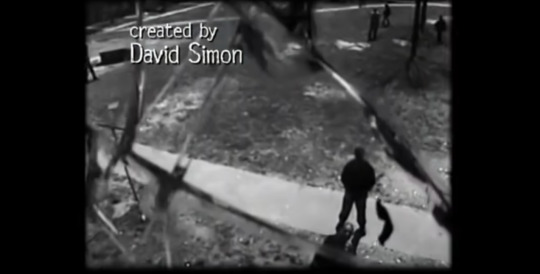
11.
In Fisher’s The Conjure-Man Dies, N’Gana Frimbo is questioned by Dr. Archer:
“You actually are something of a seer, aren’t you?” “Not at all…. I filled in the gaps, that is all. I have done more with less. It is my livelihood.” “But—how? The accuracy of detail—”
“Even if it were as curious as you suggest, it should occasion no great wonder. It would be a simple matter of transforming energy, nothing more. So-called mental telepathy, even, is no mystery, so considered. Surely the human organism cannot create anything more than itself; but it has created the radio-broadcasting set and receiving set. Must there not be within the organism, then, some counterpart of these? I assure you, doctor, that this complex mechanism which we call the living body contains its broadcasting set and its receiving set, and signals sent out in the form of invisible, inaudible, radiant energy may be picked up and converted into sight and sound by a human receiving set properly tuned in.”
ELUCID showcases his broadcasting set and his receiving set, but his carries the outlaw spirit of an illegal cable box or the pirate radio signal from the short-lived Dread Broadcasting Corporation out of West London in the 1980s. ELUCID as DJ Lepke in limbo.

12.
The title “VOICE 2 SKULL” evokes a note to self, a Nextel push-to-talk, or a voice-to-text: ELUCID as fully automated, as a cybernetic MC. But the human essence—the flesh, blood, and bone—is still there: “I get up before everyone and lose my mind first— / For even just an hour, I work in sound and feeling—sometimes fury, / Asking the whys and hows when lies turn to vows.” That is, he grinds; his work ethic, the grating of gears. He starts his day, travels where he will, but always “free roaming” and “pinging stupid” as a “transcontinental satellite receiver freaking forth.” On “XOLO,” as tek, he “reach[es] inside—only to [his] elbow, / [And] pull[s] it back out like [he] was rewound.” Like a VHS tape, or Betamax. Functioning as some new plastic idea. We’re all wired and wasting away with “mirror[s] in pockets” as we busy ourselves “looking hard in the camera.” Not squinting to make sense, merely modeling a manufactured exterior.
13.
Digital overlords don’t need free promo…
—ELUCID, ØKSE’s “Skopje”
The teknohell is ever-present on REVELATOR—you can’t escape its server rack bracket clutches. “Defrag the files,” ELUCID raps on “BAD POLLEN,” attempting to counter what Nathaniel Mackey calls a technology of decay. RFIDs, modems, CCTVs, pagers—all this tech isn’t anachronistic; it’s timeless—e-waste salvaged or scavenged—but ELUCID evolves, keeps it moving [...like a moving target], even if that means “bloody fingers on the keypad,” which we heard of on Valley of Grace. His own magnetic fields fuck up electronics; he lives in the “chaos hour shadow play” mentioned on “THE WORLD IS DOG.” “The situation’s unreal,” as Chuck D says on “Black Steel in the Hour of Chaos.” “There are no hard distinctions between what is real and what is unreal,” Harold Pinter responds. Ultimately, ELUCID is “wholly unimpressed by your social media metrics,” at least according to “MBTTS.” He offers up “brick and mortar rhyme for distorted time” and “offline [is where] [his] core thrives.” He knows what’s what: these gadgets and gizmos are “soon to be rendered useless: and then what?,” as he inquired on Small Bills’ “Even Without You.” Merchandise is Brand New Second Hand as you sit in an ergonomic swivel chair before Roots Manuva’s radiation-emitting dusty microwave. ELUCID searches for a truth beyond the motherboard.

14.
I tell you this in truth; this is not only the end of this here but also and first of that there…the end of history…the death of God, the end of religions…the end of the subject, the end of man, the end of the West…the end of the end, the end of ends, that the end has always already begun, that we must still distinguish between closure and end…. it is also the end of metalanguage on the subject of eschatological language…
—Derrida
…so let me shut the fuck up.
—Editor’s note [me]
Tell me a lie, tell me a truth becomes ELUCID’s Max Headroom mantra for “CCTV,” minus the sputtering, the glitching. We like to think that the “truth [will] find you where you at—it’s fine, it’s fair,” he raps on “RFID,” but, more often than not, revealing the truth requires trying. Your responsibility, Toni Cade Bambara insists, is to “try to tell the truth,” and “[t]hat ain’t easy.” It’s tough to summon the strength when we “have rarely been encouraged and equipped to appreciate the fact that the truth works.” The machinery of lies and disinformation come fine-tuned with a gleaming chrome finish. As for truth, we’re numb to its virtue; neutered by negative thoughts and clouded past experiences. But if we can pursue truth, prove it, and impress it upon our enemies, according to Bambara, “it releases the Spirit.”
The “cattle prod [will] shock you back some reality,” ELUCID raps. But truth can seem a hackneyed notion in the wrong hands. In Baldwin’s “Going to Meet the Man” (1965), Jesse, an abusive cop who takes sadistic pleasure in cattle prodding Civil Rights protestors, is charged with bringing the singing of jailed demonstrators to an end. He targets the “ringleader” of the group: “I put the prod to him and he jerked some more and he kind of screamed—but he didn’t have much voice left.” The protestor refuses to call for the others to stop singing, either out of defiance or debilitation from the beating he’s suffered, so Jesse’s frustration grows: “...the prod hit his testicles, but the scream did not come, only a kind of rattle and a moan.” Revisionist history can’t absolve the truth of that barbarity.
In one final [ex]plosive shout before “CCTV” transitions, ELUCID says, “Steal me your blues.” A call for reappropriation of what has already been plundered on a mass scale. The blues are never blameless. ELUCID collects blues and deranges ’em—traditional | twelve-bar | crowbarred | prison blues—deep cobalt with sapphiric crazing. REVELATOR most obviously invokes Blind Willie Johnson’s version of “John the Revelator” (1930), what with his scum gutter growl of Who’s that writin’? Jeff Place called Johnson a “guitar evangelist,” a man who was blinded by lye in his eyes at seven [the means of his marring and age should not go unnoticed], a reenactment, perhaps, of John the Revelator’s being dunked into the boiling oil cauldron—not nearly the “musky oils” ELUCID spoke of on “Obama Incense.” The teknohell is home to a Victor Talking Machine, no doubt, and the 78 RPM shellac record of Robert Johnson’s “Hellhound on My Trail” (1937) spins centripetal. RJ’s bottleneck slide screams phoenix as he sings, I got to keep movin’. For protection from the dogs—zig, zag, zig.
August Fanon and ELUCID sacrifice the frenetic for a straightforward refrain to conclude “CCTV,” something to mesmerize with layered vocals, subliminal messages not so sub- that they’re unmanageable. Take freedom: ELUCID wants you to hear the message, the charge. “All power to oppressed people” isn’t just a slogan for him; for others, as we know, it undeniably is. He asks for a “red light on the virtue signal for the come-latelys”; or, as PremRock says on ShrapKnel’s “Human Form”: “Closeted moderates post black squares then act scared of actual progress.” On “NY Blanks,” ELUCID “refuse[d] to kneel and pray for hashtag another slain name, / On the dashcam frame of sight.” Technology pervades every moment of life and language—from sonogram to dashcam and the SMS notifications of each and all else in-between.

15.
Child Actor’s production on “YOTTABYTE” traps us inside the machine with hex bolts knocked loose and rattling around. Again, technology works its way into everything. “Stints and priors, / Sweat labor, / August sun,” ELUCID raps, seemingly on a chain gang—the teknohell is a maximum security prison: biometrics | video analytics | signal-jamming | duress alarms. Data storage facilities bursting at the seams.
“Terabyte, gigabyte, niggas bite,” ELUCID spit on “Bitter Cassava,” adding with a whiff of cybersexuality, “I heard ass taste better in the summertime.” Do androids dream of having a romp with the provocatively named Deckard? Do Nexus-6 replicants have rape fantasies? “Came out the pussy and wrote a classic,” ELUCID says on “YOTTABYTE,” and I’m left wondering what Jodorowsky’s love machine from Holy Mountain (1973) might have to do with this. Cold and sterile tech-infused corporeality | conjugal visits with slinky cyborgs | proto-pornbots.
“SKP” presents as more sound poem than song—its patterns erratic, and therefore erotic—unpredictable with vocals pitched down and up arbitrarily. Andrew Broder provides a mellowed pulse backdrop, tunneling toward something visceral, and not the gear boxes and springs, the sensors and metal tubes, that make up a robot’s innards. ELUCID has previously proclaimed he was “a dyke in a past life,” a Sister Outsider standing alongside Audre Lorde: “Images of women flaming like torches adorn and define the borders of my journey, stand like dykes between me and the chaos.” “SKP”—Some Kind of Power—draws inspiration from Lorde’s “Uses of the Erotic: The Erotic as Power” (1984), which reframes eroticism, removes it from the teknohell.
I know you know the codes, ELUCID says. His lover has the key—they each possess a copy. And the key is crucial, at the crux of the relation; listen to what woods says on “INSTANT TRANSFER”: “It’s all skeleton keys on the keyring I keep, / Keys I never seen before for places I never even been, / Luxury cars—I key ’em and go to sleep.” Keys, keys, keys, as Angela Carter writes in “The Bloody Chamber” (1979)—to china cabinets and safes and every other secret place. The narrator’s husband, though, forbids his young wife from using one key in particular. Not the key to his heart, as she presumes (“skeleton key to ya heart,” ELUCID echoes on “CCTV”), but “the key to [his] enfer.” He teases and tantalizes her and throws all the keys into her lap as “the cold metal chill[s] [her] thighs through [her] thin muslin frock.” Something’s not quite right; “we was down singing off-key: how?” ELUCID says on “XOLO.” The key might crack the code | stroking and fondling | heavy petting | as artificial intelligence records the taps and timbre of your keystrokes, stealing sensitive passwords—a sensate focus therapy for anonymous internet users. Probably best to keep the key under the mat.
“The erotic is a considered source of power and information within our lives,” Lorde writes. ELUCID answers: “Knowing is enough—deepest core informing all.” The erotic, Lorde notes, “offers a well of replenishing and provocative force to the woman who does not fear its revelation.” “From here forth,” ELUCID says, “you spit, you scream, you burn my tongue too raw—be soft.” Erotic, Lorde explains, is from the Greek eros, “born of Chaos, and personifying power and harmony.” Harm may precede harmony; pain prior to reaching “beyond the posture and the program.”
“Call me out my name,” ELUCID commands, “I’ll be the one you cum for.” Even if he brushes against the sophomoric at times (“Baby, please pop that pussy for breakfast” would be one such example from the archives), ELUCID’s sex raps swerve sophisticated. Lorde says the erotic is often “confused with its opposite, the pornographic,” which would demonstrate sensation without feeling. When ELUCID says “call me out my name” to his lover, he’s exploring “how acutely and fully [they] can feel in the doing.” Lorde explains, “[A]s we begin to recognize our deepest feelings, we begin to give up…being satisfied with suffering and self-negation…with the numbness.”
The technological bent to “SKP” climaxes with connectivity (¿Tu Tienes WiFi?)—a mutual dependance—“power which comes from sharing deeply any pursuit with another person.” In 2020, ELUCID told Tim Fish about how a trip to South Africa inspired Valley of Grace (2017): “...my wife was there, she was still my girlfriend then, and she was working at a law center, working towards protecting sex workers…. So being there, she’s at work for at least 8 hours a day, and I’m in the flat just hanging out….” At the end of “SKP,” ELUCID declares “in a union made now, tomorrow anything…,” and we feel the phantom phrase “…is possible” in the absence that follows.
“There are many kinds of power,” Audre Lorde tells us, “used and unused, acknowledged or otherwise.” 2Pac, for instance, never achieved ELUCID’s level of erotic power in song. On “How Do U Want It?” (1996), Pac was forward with his proposal, seeking consent (“Tell me is it cool to fuck? / Did you think I come to talk? / Am I fool or what?”), but copped to his preference for pornographic perversions, the “positions on the floor” he invokes: “Ironic, ’cause I’m somewhat psychotic.” Lick before you bite, ELUCID raps on “BAD POLLEN,” his own nod to the erotic/psychotic dichotomy. But it’s more tempered than Pac’s imprudence. He seems to taunt Pac’s shortcomings on “YOTTABYTE”:
Wiggle with the lights on, Ripple off thrust, Ooh, it’s just us, Yes, I need it how I want it, Feel like Southern California with my belly full…
Not to say ELUCID’s erotic power is purely PG-13; it’s not. On “BAD POLLEN,” he “wake[s] up and thrust[s] inside [his] missus, / Two fistfuls of hair, [his] face buried.” Flashes of a possessive desire, an “I Wanna Be Your Dog” energy: So messed up—I want you here…in my room…I want you here. But even when ELUCID goes raunchy, it’s organic matter, raw materials—mud and bone and verdant muck—not nuts and bolts and a nexus of cables. His trysts always involve talking out the mud, crashing through the walls…, scorch, [and] stimuli response.

16.
I might work with the wires wet if we talking ’bout power…
—“INSTANT TRANSFER”
With SKECH185’s analog(ue) tape dispenser on loan (also note the Basinskian “disintegration tapes” mentioned on “IKEBANA”), ELUCID patches and splices the first bars of “INSTANT TRANSFER” in a terse trimeter:
Five side, keep the tape warm, Wrapped rays weighing way more, Racks raid how we wage war, Slack walk to a main course.
The alliterative and consonantal groupings (“wrapped rays”; “racks raid”; “weighing way”; “we wage war”; “slack walk”; “keep the tape”) and slant rhymes present an inconsistency that models a human touch—the warmth of the analog tape undermining digital media and the instantaneous [gratification and otherwise] operations of an ATM withdrawal, just as we see the plastic bank card repeatedly guided into the multi-function maw by a human hand in the “INSTANT TRANSFER” video.
Nostalgia is no retreat from the teknohell. Even on a memory song like “HUSHPUPPIES,” the hum of Integrated Tech Solutions interferes when ELUCID recalls the “static sizzle with the grease in stereo”—frying fish and the kitchen TV set in concert with one another. “HUSHPUPPIES” feels like a loose adaptation of Henry Thomas’s “Fishing Blues” (1928), a fond recollection of fish as sustenance. Both ELUCID and Thomas begin with an urgency; Thomas “went up on the hill about twelve o’clock,” and ELUCID speaks in a tongue-twisted, nursery rhyme: “Must find fried fish—it’s Friday.”
REVELATOR has us fearing for the worst: fish fried in sulfuric waters, gilled vertebrates pulled from the River Styx—but it’s not that. “HUSHPUPPIES” feels down-home, a brief view of before, of Bessie-time, of salve and saviors and stove-top safe haven. “Put on your skillet,” Henry Thomas sings, “Mama gonna cook ’em with the shortenin’ bread.” “HUSHPUPPIES” works as a child-vision folk song, much like the “choking on a church mint” episode of “Guy R. Brewer.” ELUCID is an artist composing twenty-first century folk ditties, intent on inclusion in the Roud Index. I’m wary of the “sugar water, lemon sugar, water lemon” lyric sequence, though—the words transmit, mutate, like a gain-of-function in the kitchen sink. I feel he’s trapped speaking with “the language of the on-again/off-again future, and it is digital,” as Laurie Anderson once said.
17. PEOPLE TEND TO THINK THAT A PAGER’S FOUL
In 1991, Q-Tip asked us if we knew the importance of a skypager. The responsibility fell to Phife Dawg to explain it in full:
The “S” in skypage really stands for sex, ………………………………………………….. At times I miss the pager so you don’t get vex, Having bad days like a voodoo hex, Conceptually, a pager is so complex that I be standing on the verge, ready to flex.
ELUCID portals us to that very ’90s dimension to pick up on Phife’s “-ex” rhyme scheme.
Skypage text, alphanumeric, Blind days—rain taste metallic, Dark roads lined with tall pine, Fire tongue in the annex.
Where Phife’s explication was elementary with its backronyming and monosyllabic rhymes, its simile and succinct storytelling, ELUCID’s post-millennial penchant for broken language and Holocene imagery elevates the archaic device of the skypager to the status of fetish item. One can see the huddled assemblage of survivors circled around the faint LCD glow on the annex floor, the acid rain falling through the collapsed roof.
18.
“14.4” drags us through the mass hysterics of Y2K mania with Saint Abdullah and The Lasso layering assorted ambient jazz touches to the Tron grid. ELUCID and SKECH185 fuck with the trellis modulation, raising a “Napster ’99” download speed from the titular 14.4kbps. They float over dial tones: “I dial in; you dial it down,” ELUCID says as he receives the signal from Armand Hammer’s “Landlines.” He’s charged with a “couple hundred-thousand watts,” so “do hold the line.” ELUCID and SKECH rap with “revolutionary millennial movements,” in the words of Eugene D. Genovese, “born in social catastrophe or in the fear of impending catastrophe.” Still, though, in the West African tradition, “time is cyclical and eternal; the religious tradition cannot then therefore readily provide for an apocalypse.” Fear all? Maybe it’s more fear none than we first thought.
I sometimes configure ELUCID as Aaron Dilloway (of Wolf Eyes, and—for our purposes here at present—their 2006 limited-release Dog Jaw) with a contact mic—full-contact stage presence | kilowatts killing | bringing the pain in a really real way. He wades in distortion, awash in both antiquated and active teknology (“*69—hit redial,” he remarks on “XOLO”). Hell is populated with tek—yottabytes of it like motes in sunlight, refracting his digipoetics. He announces proudly, “Afrika Islam loop in the key of my Lord,” which is a permanent—nearly park jamming—register for him to operate within. He dials in to Zulu Beats on WHBI 105.9 in New Jeruzalem and cracks codes for the afterfuture.

19. THE HAINTS OF HAM RADIO
Never polemical, ELUCID makes aslant references to oppressive histories, dating back antediluvian. One second he’s “in ya sundown town holding [his] dick dolo,” and the next he’s bouncing to bear witness to an “illegal chokehold.” He time travels from crabgrass frontiers to a sidewalk slab on Staten Island. He may be “too old to comfortably rock logos,” but he’s in-the-ever-know [and the ever-now] of former lives—he embodies Gift of Gab running from Feds in his red Pro-Keds, and he hits the racks of Saks Fifth Avenue with the Lo Lifes. Nowadays, though, he’s Naomi Klein’s No Logo incarnate. In another nanosec, he’s a po-mo narcocorrido singer reading “the note like Chalino, except it’s off the SIM card.” He’s hopping through traversable wormholes of genealogical blues “from Ham to Cush to Nimrod.” Settle our assassin’s eyes on Ham, hm?
In A Season in Hell, Rimbaud “set out in search of the true kingdom of the children of Ham.” Wyatt Mason argues that part of Rimbaud’s legend can be attributed to the rumors of him as “the scoundrel who sold slaves in Africa.” Though it’s accurate that Rimbaud was free roaming, sub-Saharan, his vagabondage through the Horn of Africa might not have included slave-trading—that point is disputed by his biographers. In The Rebel (1951), Camus called Rimbaud a “bourgeois trader” of percussion rifles and Ethiopian coffee, but made no mention of slaves. In 1994, China Achebe stated that “[w]hen Rimbaud became a slave trader, he stopped writing poetry” because poetry and slave trading “cannot be bedfellows.” When he wasn’t tagging up the Luxor Temple on a lark in Egypt or running guns across the border into Shewa land, Rimbaud’s travelogue was interlarded with diagnoses of typhoid, synovitis, and osteosarcoma—his right leg eventually lopped off. Perhaps we can ascribe his disease-ridden body to A Season in Hell’s most profane moments, such as when he writes, “I’m an animal, a nxggxr. But I can be saved. You’re all fake nxggxrs…”

The so-called “curse of Ham,” a blasphemy on Black people courtesy of Christian whites, has long contaminated the discourse—a shibboleth adorning the flowstones and helictites of the teknohell. “According to the scriptural defense of slavery,” Eugene D. Genovese writes in Roll Jordan Roll: The World the Slaves Made (1974), “...the enslavement of the blacks by the whites fulfilled the biblical curse of Ham.” But Genovese’s research indicates “the slaves did not view their predicament as punishment for the collective sin of black people. No amount of white propaganda could bring them to accept such an idea.” When ELUCID talks of “hammers hang[ing] on loop” on “THE WORLD IS DOG,” or “hammers out the Hummer” on “VOICE 2 SKULL,” I construe this cargo pants weaponry, this pakinamac in the back of the Ac’ (or Hummer), as a means of countering white propaganda, comparable to Treach’s chainsaw or Havoc’s scythe. Throughout REVELATOR, we find ELUCID going ham—hard as a motherfucker—but ELUCID’s too humble for any Tisci gilded throne. Instead, think of him as John Henry driving steel through the carpal tunnels of sinners and thieves. He sings a Scaramangan screed as he works, something gleaned from Seven Eyes, Seven Horns (1998): “Alphabetic hammer, magnetic grammar.”
ELUCID advances with “apocalyptic movement,” which Derrida defines as “the gesture of denuding or of affording sight,” a gesture which is sometimes “more guilty or more dangerous,” such as when Noah gets krunk in his tent and “Ham sees his father’s genitals.” ELUCID sees through the myths, the slander; instead, he exposes us to a soundtrack of staticky swells as he ascends out of the teknohell. I imagine the noise is a replication of what Joyce’s radio in Finnegans Wake (1939) sounds like. Here’s that signal recounted superlatively:
tolvtubular high fidelity daildialler, as modem as tomorrow afternoon and in appearance up to the minute…equipped with supershielded umbrella antennas for distance getting and connected by the magnetic links of a Bellini-Tosti coupling system with a vitaltone speaker, capable of capturing skybuddies, harbour craft emittences, key clickings, vaticum cleaners, due to woman formed mobile or man made static and bawling the whowle shack and wobble down in an eliminium sounds pound so as to serve him up a melegotumy marygoraumd, eclectrically filtered for allirish earths and ohmes.
In Kodwo Eshun’s More Brilliant Than the Sun (1998) | [“MBTTS,” ahem], he writes that “Long-distance telecom systems intensifies sensations of imminent Revelation.” Oh, indeed.
20. POST-INDUSTRIAL DOOM GOSPEL FOR THE GODLESS
On “Old Magic,” ELUCID announced himself as the “revelator, armed and dangerous,” so nothing he does on this album should come as a surprise. This lot of doom gospel spells shatters expectations, though. “I’ve been revelatin’” is what he told us on “Smile Lines,” and he’s yet to cease or even slow. The Book of the Seven Seals bulges, busting its binding and bending back its raised bands. REVELATOR, lyrics transcribed and beats notated in neumes, passes as ELUCID’s Book of Revelation.
I see it all, Michael Gira throat-sings. I see it all I see it all I see it all I see it all I see it all… over the sunn oh godspeed charnelhouse chanting and gunmetal grind of SWANS’ “The Seer” (2012). ELUCID is all-seeing as well—omniscient shit. It wasn’t always this way. On “Blame the Devil” from Save Yourself, ELUCID admitted that “revelation had [him] spooked.” In his preface to The Adventures of the Black Girl in Her Search for God (1932), George Bernard Shaw describes the Book as “a curious record of the visions of a drug addict which was absurdly admitted to the canon under the title of Revelation,” which only adds to the terror for an ’80s child who grew up with crushed crack vials underfoot.
On “Blame the Devil,” ELUCID saw the “seven eyes, seven crows” and “was lost.” “Now I’m found,” he would continue, “End of days—amazing time, / Everybody’s got a word—mine just happens to rhyme.” No longer cowering in church corners, surrounded by the congregants of what he has called a “death cult,” ELUCID’s Revelation remix has a liberation theology reverb. Pablo Richard’s Apocalypse: A People’s Commentary on The Book of Revelation (1995) places the curious record in the context of revolutionary power:
Revelation arises in a time of persecution—and particularly amid situations of chaos, exclusion, and ongoing oppression…. Revelation transmits a spirituality of resistance and offers guidance for organizing an alternative world…. Revelation is wrath and punishment for the oppressors, but good news (gospel) for those excluded and oppressed by the empire of the beast…. Revelation teaches us to imagine the present and final eschatology with a sense of joy and hope…. The book of Revelation is helping to create a new historical and liberating language.
21.
In The Book of Revelation: Apocalypse and Empire (1990), scriptural scholar Leonard L. Thompson points to the difficulties of understanding the “symbolic, metaphoric, even bizarre language of the seer.” John the Revelator confessed to being “in the spirit” when he composed the book, what Eugene D. Genovese might call “religious frenzy” in another context. Thompson receives the Book of Revelation as a nesting language, one in which “highly symbolic language” nests into “ever-larger contexts—ultimately into a cosmic vision that includes the whole social order, the totality of nature, and suprahuman divinities that invade but transcend both society and nature.” I think it wise to receive ELUCID’s lyrics in a similar manner. Lucien Goldmann might call it Towards a Sociology of the Rap Album. “The seer tends to develop his material concentrically into ever-widening rings,” Thompson contends. ELUCID reps such a structure in his verses, in his songs, even lending his own phraseology to the process, be it those “shimmer rims spinning loopy” on “VOICE 2 SKULL” or the “orbitings” we hear about on “IKEBANA.” ELUCID will “leave the meter running” only to “trigger doomsday.” He sips “Ethiopian coffee” and seconds later “space junk” floats by. We’re hipped to the particular and the panoramic. Scaramanga was similarly skilled. Samuel Diamond writes of how “Seven Eyes, Seven Horns” is “as much a meditation on symbology, semiotics, and brand identity as it is an erudite MC’s spin on a passage from the Book of Revelation.” Or, as Scaramanga Shallah himself says on the song, “What a script…” [as in, whew].

22. MYSTIC STYLEZ
All a mystery…
—“THE WORLD IS DOG”
…nothing could have been more impressive than this cool, deliberate deep voice, stating a mystic paradox in terms of level reason.
—Rudolph Fisher, The Conjure-Man Dies (1932)
To bring it back to that damnéd Derrida essay once again [back is the incredible], MC Deconstruction redefines “apocalypse” as revelation: “Apokaluptō, I disclose, I uncover, I unveil, I reveal the thing that can be a part of the body, the head or the eyes, a secret part, the sex or whatever might be hidden, a secret thing, the thing to be dissembled, a thing that is neither shown nor said…” This revelation “not only affords seeing but also affords hearing/understanding.”
We’ve prior seen ELUCID as mystagogue—a mystik journeyman, a Walkman invader—he whose function is to initiate us into the mystery. As Guru was above the clouds, the mystagogue positions himself, according to Derrida, “above the crowd [which] he manipulates through…a crypted language,” but, despite what some dum-dums [to borrow a term from diggity Das EFX] may argue, ELUCID is not beyond understanding. We must strive to understand misunderstanding; we must endeavor forevermore to miss understanding. Those who throw fits and fail to accept these norms—I have to presume—have not been listening to hip-hop very long or well. “Words mean things but don’t have to,” ELUCID declared with Derridean flair on “Split Tongue.” “[I]f anything has outlived its usefulness it is ‘coherent’ metaphor, one with explicit contours,” writes E. M. Cioran in The Trouble with Being Born (1973). “It is against such metaphor that poetry has unceasingly rebelled, to the point where a dead poetry is a poetry afflicted with coherence.” “I’m okay with not understanding,” ELUCID said on Small Bills’ “Here Be Dragons,” “—I’m okay in the dark.” Dark Man X knows all directions.
Listening to ELUCID’s music, you enter a delirium, which Derrida refers to as a Verstimmung��“a social disorder and a derangement, an out-of-tune-ness…. The tone leaps and rises when the voice of the oracle takes you aside, speaks to you in private code, and whispers secrets to you.” On “IKEBANA,” ELUCID cops to “talking out [his] head, a fever set in.” Like Rimbaud in Obock, shivering, with his knee gauzed over, not a poetic thought to be found.
23. SOUND & CEREMENT
Sound has a grammar to it—believe me—that will cause that thing that you call bending to open up in a way you won’t believe it.
—Ornette Coleman (2005)
…I just bend the rhyme…
—“Sir Benni Miles” (2021)
ELUCID, more than any other active MC, embodies a compositional approach that conflates poetics and musicality in a manner that doesn’t favor or diminish either—symbiotically rendered, synchronistically flexed: the orphic bend. In an epistolary novel by Nathaniel Mackey, Orphic Bend denotes a fictional album title of a fictional band. ELUCID asks on “RFID”: “Why play if I can’t bend the rules?” To forbid ELUCID these ludic junctures would be ludacris, a loss of not only file data but of finely wired rap filigree. ELUCID stays bent in both senses—his sentence inclinations, his word inebriations—bent like Miles Davis’s mouthpiece; dead bent like DOOM’s swilling death-drive to fund these experiments. These are “games I win at—mark me,” ELUCID gloats, but he also invites us to “share this reality.” If we’re willing, he’ll leave none of us behind; he won’t orphan us.
“We’re all eventually orphans,” Mackey has said. Elsewhere (namely, “Sound and Sentiment, Sound and Symbol [1987]), he kindles, he forges, the meaning of orphan and Orphic, “an orphan being anyone denied kinship, social sustenance, anyone who suffers, to use Orlando Patterson’s phrase, ‘social death.’” Mackey continues:
Song is both a complaint and a consolation dialectically tied to that ordeal, where in back of “orphan” one hears echoes of “orphic,” a music which turns on abandonment, absence, loss. Think of the black spiritual “Motherless Child.” Music is wounded kinship’s last resort…. Music is prod and precedent for a recognition that the linguistic realm is also the realm of the orphan…. This recognition troubles, complicates and contends with the unequivocal referentiality taken for granted in ordinary language…. Poetic language is language owning up to being an orphan.
ELUCID has previously instructed us on “the difference between loneliness and being lonely,” referencing like a hand reaching out—to Gwendolyn Brooks, who feels the “under buzz” of loneliness. But ELUCID’s bent is in the direction of populating his cathedral with the motherless children of his bastard style.
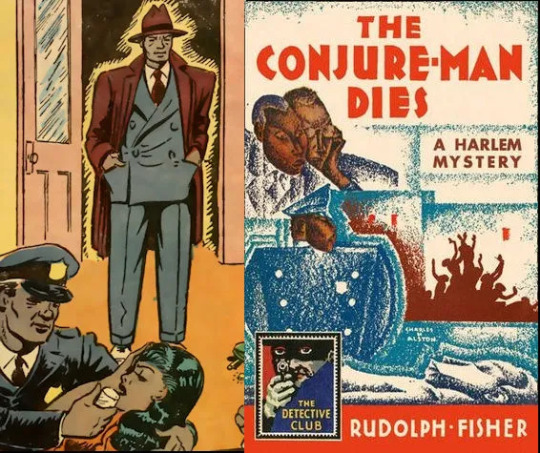
24. INSIDE REPEATING NUMBERS
To stave off the dogs, the teknohell, and the unknown opps, ELUCID makes endless calculations but with an imprecise science. One can imagine the setting for such calculations resembling N’Gana Frimbo’s consultation room, what with “obliquely downcast light” and “lateral walls…adorned with innumerable strange and awful shapes.” Those strange and awful shapes—like glyphs carved onto dusty clay tablets—included “gruesome black masks with hollow orbits, some smooth and bald, some horned and bearded; small misshapen statuettes of near-human creatures, resembling embryos dried and blackened in the sun…forbidding designs.” The conjure-man’s mantelpiece showcases a “murderous-looking club, resting diagonally.” The club is actually “the lower half of a human femur, [with] one extremity bulging into wicked-looking condyles, the other…covered with a silver knob representing a human skull.” ELUCID holds the club like a stylus, dealing in tally marks and totalities until the skull smudges out an answer.
Numbers are concrete, seemingly. “Numbers don’t lie, but they damn sure don’t tell stories either,” ELUCID rapped on “NY Blanks,” skeptical of statistics. On “IKEBANA,” he starts with “3800 out the credits.” I ain’t count it, he admits, “but it’s sweat labor.” He narrows the narrative with estimates: “ten or something”; “on time, but off-key”; “almost, almost over…so close…almost over….” These are “complicated chemicals” that only work to deepen what Rimbaud called “numerical visions.” Do the math. On “YOTTABYTE,” it’s “dead money [and] thirteen guineas for a pickaninny piano.” On “BAD POLLEN,” he “brought a trunkful of tiny violins to the bloodletting.” ELUCID can “play one on each finger for every seven bodies.” These aren’t exact measurements or accurate costs. As he says on “INSTANT TRANSFER,” he’s “counting up in the dark” (in Frimbo’s consultation room, right?). Persevering and perseverating on “14.4”: “System error, / Less than zero, / Humanity pending.” Sounding like he needs to get his affairs in order.
The numbers game inevitably leads to money—nasty business like toxic assets and credit derivatives—and money is time; time, money. “Can’t clock the kills,” ELUCID says on “THE WORLD IS DOG,” echoing Master Ace in ’90 (“Can’t Stop the Bumrush”) and Jay-Z in ’96 (“Can’t Knock the Hustle”)—earning miles while on the clock as a touring musician, tallying transatlantic and domestic flights. But is there ever a time when he’s not “waiting on money, thinking of murder,” as he raps on “BAD POLLEN”? Does the hustle, the bumrush, the killing ever cease? Or is it an interminable loop of episodes mimicking bell hooks’ oft-quoted (by all the wrong people for all the wrong reasons) opening sentence from “Killing Rage: Militant Resistance” (1995)? “I am writing this essay sitting beside an anonymous white male that I long to murder,” hooks wrote. “I’m at the age they start to count my nights out,” ELUCID raps on “VOICE 2 SKULL,” because death or revolution seems “a black power nap away” (“IKEBANA”). “Time wore us out,” according to ELUCID, speaking in the past tense as if the deal has already gone down, the jig is up, the end is here. The “24-hour drones” he mentions on “14.4” survey the damage. Too easy to get greedy and selfish at the end (“Give me a minute…give me five…”), shuffling off this mortal coil as “we wait—who knows the hours?”
25.
“IKEBANA,” despite the time-and-numbers crunch, sketches a scene of restorative habits, a survival guide for the godless. It falls short of He-is-risen optimism (Orpheus is the figurehead here, not Jesus), but we’re headed from hell to the heliosphere. ELUCID wishes the world “good morning” with “oatmeal” and “Ethiopian coffee.” He’s calculating to find peace. He feels that “everybody knew” but him—crying it out; they must know the secret to peace. Miscalculations leave him envious. Everyone laughing at his ignorance, at “all [his] comings and goings”—the state-of-the-art GPS tracking of the teknohell. RFIDs on the heels of his feet triggering field detectors.
The solution is a sometimes-turn inward: Being alive, I must look up. If the Ethiopian coffee doesn’t cut it, he’ll order an “everything bagel with the tofu scallion” or “vacuum the whip” (as he does on “VOICE 2 SKULL”). We’ve heard of his domestic resolve before. On woods’ “As the Crow Flies,” ELUCID was “cleaning up [his] kitchen, / Emptying the fridge, bleaching counters, [and] sweeping corners.” By placing his “silverware in order,” he rebuilds the rubbled world. Peace is plucked from panic elsewhere, as on “YOTTABYTE” where he’s “squatting in a Barcelona hotel room playing Wu-Tang Forever,” observing the world rather than his phone, nourishing himself through sights rather than storing up the cache and cookies of his frequently visited sites.
After many calculations, the epiphany points toward what he details on “BAD POLLEN”: “I squeeze my children’s hand and walk harder against the wind,” the same wind that rustles the dead roadside bracken, as Cormac McCarthy writes in The Road (2006). ELUCID turns to his children, his family. woods, it should be stated, does the same, as noted on “Niggardly (Blocked Call)”: “I walk ’em to school, then the park, / Hold they little hands when we cross the street.” A small step to cross the street is far simpler than crossing the Rubicon.
“IKEBANA” is another ELUCID and Jon Nellen production, and Gabriel’s muted horn is buried in the mix of the song’s bridge, a distant and dour reveille as ELUCID sings softly. As he bemoans everybody knowing what he doesn’t, Nellen’s percussion pulls us to where ELUCID wants to be: looking up. Being alive, he’s looking up out of hell. We hear his will to struggle, to survive, and to exist, but we also hear our will to “look up,” or research meaning, reflected—manufacturing it if we have to—as in, “You must learn” (life being nothing more than a boogie down production). Improve ourselves through awareness of others, of our loved ones especially, of our situation within all the scattered “scorching space junk, x’s and orbitings.” You must change your life, in Rilke’s words.
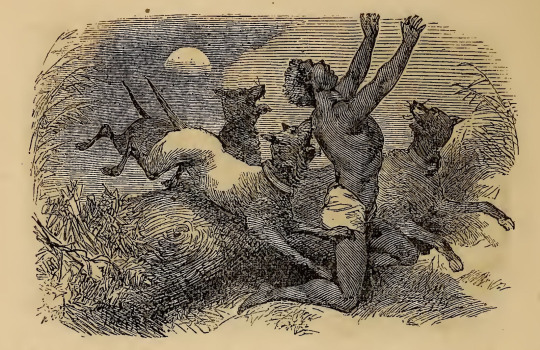
26. MAN THREATENS LANDLORD
Kill your landlord, no doubt…
—“Roaches Don’t Fly” (2021)
“SLUM OF A DISREGARD” celebrates thirty years of skullduggery since The Coup’s “Kill My Landlord” (1993), but underhanded housing policies—what ELUCID calls “comforts of material conditions core-rotted”—are nothing new. Look at Langston Hughes’ “Ballad of the Landlord” (1940):
Landlord, landlord, My roof has sprung a leak. Don’t you ’member I told you about it Way last week?
Last week is “way last week” because any leak sooner than soon, quicker than quick, becomes an inundation, a deluge, and the subsequent damage, mold spores, and stench overwhelms. Hughes’ subject alludes to withholding rental payment until the landlord “fix[es] the house up new,” but the landlord threatens back with “eviction orders.” The threat is communicated through the tenant’s account, through a series of questions—a dialogue masquerading as a monologue for the first five stanzas of the poem. The landlord is absent, a ghostly presence only there to extract profit. When the tenant turns to intimidation (“If I land my fist on you…”), we suddenly hear the landlord’s voice summoning police and precipitating an ugly and familiar scene:
Copper’s whistle! Patrol bell! Arrest. Precinct Station. Iron cell. Headlines in press…
For his threat of violence (which the landlord exaggerates as an attempt to “overturn the land”), the tenant receives a sentence of “90 DAYS IN COUNTY JAIL.” But for his neglect and threat of dispossession, the slumlord suffers nothing.
“The house is built on deceit,” Boots Riley raps on “Kill My Landlord,” acquired through primitive accumulation and the successive decades of sniping and stealing, compressing a courseload of Proudhon property is theft readings into a solitary verse. ELUCID’s landlord—nay, slumlord—is on a “Tel Aviv holiday” when the crisis hits. While the landlord uses ELUCID’s monthly rental payments to feed IDF soldiers [...my taxes pay police brutality settlements, billy woods shouts back], ELUCID struggles to get him on the phone. When he does, he finds the slumlord’s “sincerity was threadbare” and “urgency been missing.” ELUCID “smile[s] like watermelon slice,” a simile which upends the slumlord’s own race-based neglect through subversion. ELUCID will grin and bear it (for the time being), but he won’t let it go without signaling to the slumlord—or himself at least—that he’s privy to the power dynamics which undergird the exchange. In doing so, ELUCID enacts a stratagem used by poets before him. “We sliced the watermelon into smiles,” Terrance Hayes writes for fourteen consecutive lines in one of his sonnets from American Sonnets from My Past and Future Assassins (2018). In Langston Hughes’ “125th Street,” the poet doesn’t allow racist stereotypes to overshadow Black joy:
Face like a slice of melon grin that wide.
Hayes, Hughes, and ELUCID invoke historical [mis]representations by combining the smiling, subservient Tom caricature with the conniving, watermelon-thieving Coon to deliver a knowing wink to the reader/listener. In a promo video for REVELATOR, images of James H. White’s Watermelon Contest (1896) flash across the screen—an Edison film under Brakhage-like production techniques.
The longer ELUCID stays on the line with his slumlord, the sharper the sting. Mahmoud Darwish once asked, “Why did you lean on a dagger to look at me?”—and ELUCID listens long-distance to the slumlord “turn the dagger slow” with every second that passes. This is an abrasive exchange—ELUCID’s complaints and his characterization of the slumlord’s speech effectively evoked through consonance: “Too late to make it right, / Tongue-tied talk, / Make noose quick.” The slumlord stumbles over his words, speaks offensively, and we’re reminded to “believe what people say they are and do.”
Like “Ballad of the Landlord,” the conversational lines within “SLUM OF A DISREGARD” are one-sided. We hear ELUCID, in father-mode, pressing: “If this happens all the time, what’s the plan?” The slumlord’s excuses are elided, for his words are meaningless drivel. “Both my boys have my eyes,” ELUCID coldly explains, “—don’t force my hand.” His hand, like the tenant’s fist in Hughes’ poem, communicates to us that stakes is high. “Don’t force my hand,” he pleads, but Darwish writes that “we are forced to return to the inhospitable myths / where we have no place.” On “Between the Lines” (2001), Slug rapped: “If I see you as a threat to my seedling or my sibling, / I’ll die to pull the plug on your machine.” This kind of escalation really isn’t escalation at all—it is meeting the violence of the slumlord, a violence aimed directly at the face of children. “Black mold, / Black lung, / Black child,” ELUCID chants, delineating the equation. He receives “no callback” and his fury rises. An international call culminating in a rat’s nest of cords and wires—a switchboard in a landfill.
“Abuse of power comes as no surprise” isn’t just a Jenny Holzer holdover, it’s ELUCID seeing and stating that which has become so tiresomely obvious. We would have to delude ourselves to see something other than what stands before us. “I am not a prophet claiming revelation, or that my abyss reaches heaven,” Darwish writes in “Mural” (2003), “By the full power of my language I am the stranger.” We’re no stranger to oppressive language, language that oppresses. On October 9, 2023, Israel Defense Minister Yoav Gallant said, “We are fighting human animals and we are acting accordingly.” A year later, nearly to the day, ELUCID tells a truth to counter that lie: My landlord is a Zionist.

27. FRESH AS FUCK ON STOLEN LAND
With his home in disrepair, ELUCID looks elsewhere to ease the tension of his rent-strife. “IN THE SHADOW OF IF” documents a search for refuge. He seeks to construct alternate realities and “alt timelines” where he’s making “[his] own breaking news” and “Lucy shit[s] diamonds” instead of habitating the sky with them, her kaleidoscope eyes gouged out. But you would need kaleidoscopic vision, of sorts, to manifest such a place. Though ELUCID has copped to “nam[ing] a thing or two into reality” on “SKP,” “IN THE SHADOW OF IF” postulates an added if—if he wasn’t “born in the year of this country’s last recorded lynching,” maybe he’d be better off. But as he says on “Microdose,” the question—and the reality—is “who stopped recording?”
Fleeing the city, ELUCID heads upstate and beyond—somewhere coastal that he can walk “barefoot in the sand.” We discover him “stepping over dead fish in a bucket hat.” This is the downbeat of deep ecology. “Salt and sulfur,” he raps, and he “can’t tell where the wind blows.” Gusts die down and Hell reemerges (as if it ever left) | guts tighten. “I’m on that Black leisure for the increase,” he says, calling in a reservation at The Black Dog while reclined on his beachchair on Martha’s Vineyard’s Inkwell. ELUCID uses his ink well. But this all seems a reverie, an abstraction, as he challenges us to “pick a coordinate / [And] show [him] where localized perceived violence didn’t come with receipts, / White sheets.” Klan presence pervades any and all vacay getaways. You might not see the hoods and horses up north, but you will see “too many flags—one too many flags.” He’s not gonna front, “seeing all those flags outside the city make[s] [him] nervous.” These are ELUCID’s dead flag blues. They represent “physically violent reminders.” Natasha Tretheway writes that flags “inscribe both a figurative and literal white supremacy onto the physical landscape and the psyche landscape of the American imagination.” Go back to “The Blackout” (1998) where Jadakiss warned that those “rednecks up in the mountains’ll try to slay you.” ELUCID ends up feeling like he’s “been cursed to concrete,” cordoned off by external forces, told to stay in the city, which makes him wonder how he’ll keep from going under.
“The devil is a lie,” he exclaims, realizing “we are the ecology.” The mob made the devilry, manufactured it out of gurgling hate, and unfortunately “a moment to pause never goes on sale,” so peace can’t be purchased. ELUCID told us he was a “green book reader” on Armand Hammer’s “Stole,” navigating the netherworld of where no Black man, woman, or child is welcome. Time is warped; he angles through a simultaneity of oppressive timelines—“twenty years behind and ahead.” The “Black futures” he sought to build on “Stole” start to feel unattainable. Instead, he finds himself gripping “black steel in the hour of submission in search of a place to land… / …in search of a place where our blood don’t precede us.” Fact is, they built it on Indian graves. The land is composed of blood-soaked soil—runaway slaves torn to shreds, lynchings, and extrajudicial killings. On the original “Black Steel,” Chuck says, “Here is a land that never gave a damn.” ELUCID wants “purple rain” and “wild greens,” a lush and fertile vista where’ing the flowers grow and the price of avocados is free. “Search[ing] for a place to land”—forty acres won’t do. Can a reparations calculator really tell the cost of dispossession and plunder?
28. WHO’S THE SUN SEEKING?
Xoloitzcuintli guides ELUCID into Hell, but ELUCID guides us out of Hell, penning a travelogue in miniature—traffic patterns and images of languid BK denizens. Virgil-level guidework, as Mos Def once said, “from the tree-lined blocks to the tenements,” so you don’t get vicked. On “No Grand Agenda,” ELUCID spoke of his “daydream on city buses, / Brooklyn pushing [his] button,” and on “XOLO,” we appear to receive the full panorama once the sound of sulfuric screeches and barking dogs in the distance fades:
Staring at the sun— a corner florist fell asleep with his mouth open on St Felix, downhill on Dekalb, Green light succession, Stop-and-go, rubbernecking, Swerve, change directions, Head in a smoke cloud…
He squints through the sunlight so that “he won’t burn” his retinas. Not to worry—he comes protected. REVELATOR’s cover image (photograph’d courtesy of A. Richter) shows ELUCID in shades. We can map the antecedents—be it Miles Davis’s shield sunglasses, Porsche 5620s with the frame screws (precursor to Kool Moe Dee’s steez); be it Sun Ra’s Courrèges Eskimo slit glasses that he rocked on the cover of Rolling Stone in 1969; be it Afrika Bambaataa’s future-geometry set of shades. ELUCID’s might as well be a Makrolon face-shield, as he’s protected from the welder’s flash of Hell’s ultraviolet flames. On “CCTV,” he fends off the “sunshine and teargas,” the “flash bang” of dispersal orders, the anti-crowd dog’s growl and howl, the Brooklyn confetti of uprising. He does so just as the Irish travailed through the Troubles, as depicted with punkish punctuation in Ciaran Carson’s “Belfast Confetti” (1989)—with shrapnel (the titular “confetti”) in motion like movable type. ELUCID’s text goes explosive in the same ways as Carson’s: “Suddenly as the riot squad moved in, it was raining exclamation marks, / Nuts, bolts, nails, car-keys. A fount of broken type.” ELUCID’s sunglasses allow him to “see now”—all the “details” with “color-cut clarity.”
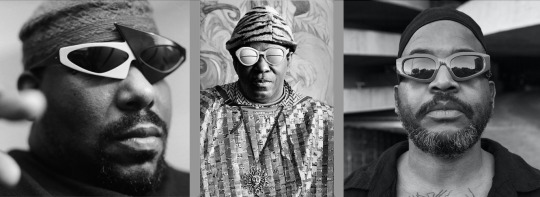
Elevating out of Hell requires him to forge his own way, an avenue that becomes familiar: “I’m acclimated, black upon a path, / I made it outta clay.” Rakim crafted in the same Creator-cum-MC way on “Follow the Leader”: “Planets as small as balls of clay.” Get the fuck back, ELUCID orders, Stay the fuck down. Run for your life; duck down—his alarum’s a Rude Awakening. When ELUCID summons N.O.R.E.’s “theoretical niggas on the run eating,” the tempo starts to increase, steadily. Fire kindles and ELUCID says what we already feel: “The house is burning here…yeaaaah.”
In William Melvin Kelly’s A Different Drummer (1962), Tucker Caliban is a slave descendant who, after serving the Willson family for generations, has had enough. He shoots dead his livestock, salts his land, and sets his house aflame in an act of defiance. The Lasso’s tempo-shift tracks with Kelly’s description of the inferno:
Orange flame climbed the white curtains in the center section of the house, moved on slowly to the other windows like someone inspecting the house to buy it, burst through the roof with the sound of paper tearing, and lit the faces of the men, the sides of the wagons, and the faces of the Negroes…. Sparks curled up and then died, dissolving against dark blue sky…. [T]he rubble of the destroyed home looked like a huge city seen at night from a great distance.
Tucker’s family leaves the town of Sutton and the other Black residents soon follow, baffling the white residents who watch the procession of “suitcases or empty-hand[s]” headed for the state border. As a crowd watches Tucker blast bullets into his horse and cow, witnessing the “sticky blood r[u]n down” their fur,” as they watch him ax “the twisted tree” on the Willson Plantation, “on which his great-grandfather and grandfather had been slaves and then workers,” they think he’s gone mad. Enlightened Harry Leland refutes this, though. “It’s his land. He can do anything he wants to it,” he tells his young son.

29. P.L.O. STYLE
You may burn my poems and books You may feed your dog on my flesh…
—Samih al-Qasim, “Enemy of the Sun” (1968)
ELUCID dropped a zim zala bim on Armand Hammer’s “Solarium,” but—in recognition that magic can’t be the only survival method—he now promotes a zigzagzig. DJ Haram provides the sound design—a metallic gnashing, a chittering of rebar stakes, and a bass that throbs, muted and distorted, like eustachian tubes swollen from proximity explosions. On “Old Magic,” ELUCID offered a “double portion of protection,” but even charms and conjurings aren’t always enough. Under “war clouds” and a “cruel sky,” his “niggas survive like a moving target.” Zig. Zag. Zig. With the Knowledge, Wisdom, and Understanding of the last letter in the Supreme Alphabet—the zed, the end. Another bend of the body—an Orphic bend toward protest. The thousands upon thousands of Gazan orphans crying out to be heard.
For years, dead prez’s M-1 has argued that the struggle for Black liberation and the struggle for Palestinian liberation were “the same struggle.” “We have always been an international cadre,” he has said, “We have to see ourselves as a movement without borders.” Teknology allows deaths far and wide to be televised, rewound, reproduced on a “watch again” | replay | “share” exploitation loop. “I didn’t watch the video,” ELUCID says—and who can say which video? We wade through yottabytes of video footage like tonnes of debris. The video could be of grieving mothers in Khan Younis carrying the corpses of children, or it could be of Philando Castile bleeding out in the passenger seat of his Oldsmobile 88. ELUCID willed himself to not watch the video—to not tune into the Black death | Palestinian death broadcast—because he already “remembered in [his] body,” in his bones in which the trauma sings, in the code genetically imprinted.
The specter of Palestine pervades REVELATOR. Listeners are more likely to scan ELUCID as “abstract rap” than “conscious rap” or “political rap,” but that’s only because ELUCID’s art is so innately revolutionary and activist, lacking the sharp edges and defined features of more contrived artists. The abstraction is that the unacclimated will perceive ELUCID as a mystic on the mic rather than a rebel. He can be both; he can defy categorization; he can perform more powerfully than any single genre tag or pigeonhole could signal.
The history of solidarity reaches back to the 1970s with communiqués shared between the Black Panther Party and the Palestinian Liberation Organization (Method Man’s P.L.O. Style would never…). Kwame Ture (née Stokely Carmichael) dreamt of “having coffee with [his] wife in South Africa” and “having mint tea in Palestine.” Liberatory lucid dreaming. We collectively hope—and work—for better futures, for the dogs of Abu Ghraib and the hounds of the Great Dismal Swamp pace the same Hell. “I shall not compromise,” Samih al-Qasim writes, “And to the last pulse in my veins / I shall resist.” al-Qasim’s poems were discovered in George Jackson’s San Quentin cell after his death. “Enemy of the Sun” would even be misattributed to Jackson because he had transcribed the poem by hand.

ELUCID finds the energy, the caloric boost, in “locust and wild honey”—embracing this ascetic appetite of John the Baptist. He changes out his alpenflage cargo pants for a camel’s hair robe and leather belt about his waist (getting down with the animal pelts). He shelters in a “deeper shade of carnage,” turned from a whiter shade of pale, and “stare[s] into the fire,” scrying, divining answers from the glowing embers. On “14.4,” he said he “live[s] between two mirrors,” spitting catoptromancy raps wearing the “bulletproof Girbaud” from “YOTTABYTE,” backpocket containing a bulletproof wallet. Layers of protection. It’s the only way to “fix up sharp,” as he says on “IKEBANA” with dizzee rascality. Dressed to impress, he’s a “stiff-lip maroon.” In Maroon Societies: Rebel Slave Communities in the Americas (1973), we learn that “in Surinam, as in Haiti, Jamaica, and elsewhere, warriors underwent complex rites and wore amulets intended to make them bulletproof…. [I]t was their gods and obeahs that spelled the ultimate difference between victory and defeat.” You already know ELUCID’s been spellling. And because the world always has been and continues to be dog, Cujo, Stephen King’s rabid St. Bernard, can be traced to Cudjoe, the Jamaican maroon leader. “A fearless rebel [who] boasted numerous bloody victories against the British,” Boisseron writes.
When ELUCID sees the “heads of state laughing” on “ZIGZAGZIG,” he knows they’re “liars” and that “hate has a logic.” They laugh “an idiot’s unbearable laughter,” to quote Rimbaud, still sweating through his Hell szn. But so are we all, grappling with the fact that “there’s no conscience, no authority.” ELUCID “live[s] to tell the story, / …to sing the song”—witness to atrocities, articulator of awfulness. When he can, he hammers out a warning. But he’s always on alert for imminent attacks which strike “without a warning.” Despite our teknological advances, we’re still a primitive society—our world still reduces to rubble, routinely. MPR500 precision-guided missiles fall from the sky and a Palestinian child stashes snacks in an abandoned IDF ammunition box. We search for survivors by hand—“Stony ground, metal poke out rubble, / Body twist angles akimbo, / Covered heads huddled”—hoping and praying for signs of life—head aching like rebar through skull, an inglorious Phineas Gage.
On “Revelation Narrative” from Horse Latitude (2017), we hear the voice of a young child calling out: I want mama. How prescient. But the past tells the present, the future. 1948 | 1967 | 1987 | 2000 | 2008 | 2023 | & every increment in-between. ELUCID calls “from river to sea in lieu of peace, absence of truth.” He finds the gutless heads of state ��guilty as charged.” They’re “monster[s] out the darkest abyss,” and—like dogs, like hellhounds—they exhibit a “gnashing of teeth.”
The death toll tolls for thee. John Donne felt the weight of every dun: “Each man’s death diminishes me, / For I am involved in mankind.” ELUCID makes the same pitch, even to those deaf to reason. His mathematics don’t need to be supreme; the most basic arithmetic tells a truth:
Who can still ignore the score? One more—to what end? Man-made horror beyond comprehension.
30. I WOULDN’T TRUST IT IF THE POET DOUBT
After Revelation come a Genesis…
—Small Bills, “Falling Up” (2020)
No variety of literary originality is still possible unless we torture, unless we pulverize langage.
—E. M. Cioran, The Trouble with Being Born (1973)
ELUCID pulverizes language. The lyrics on REVELATOR read like Bible page cut-ups, like Gysin and Burroughs put the scissors to ’em, like garbled Ghostface transcriptions. Narrative gets negated—not to confound, but to complicate communication. In doing so, ELUCID mirrors our shattered contemporary speech patterns, only it's art not the garbage glibness that the Geto Boys apprised us of in ’89—talkin’ loud but ain’t saying nothing. His Orphic bend and cadence flexing leave us levitating, lost in what Rimbaud calls a “hallucination of words.” More from Rimbaud:
I regulated the shape and movement of every consonant, and, based on an inner scansion, flattered myself with the belief I had invented a poetic language, that, one day or another, would be understood by everyone, and that I alone would translate…. Worn-out poetical fashions played a healthy part in my alchemy of the word.
On “VOICE 2 SKULL,” ELUCID cops to “complicating noun combinations over drumbreaks.” He felt the existing “language insufficient—chess pieces to the checkerboard.” His new language includes words for the living and “words for the departed” (“ZIGZAGZIG”), as if a seraph touched a burning coal to his lips. His diction ushers in cosmic agonies. His voice is “the strange instrument of death,” loaned from the conjure-man Frimbo. Listening to REVELATOR, I see the colors, geometry, and nonlinear wanderings of Wadada Leo Smith’s scoring of improvisation, his Ankhrasmation language articulated into words.
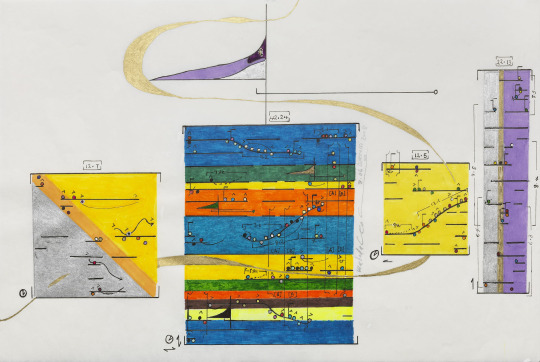
31.
In 1965, Amiri Baraka ended his liner notes to The New Wave in Jazz on this hushed note: “New Black Music is this: find the self and kill it.” Nathaniel Mackey has interpreted Baraka’s statement in the following way:
...in the course of improvising and getting to the point where you can play free music, you have to find yourself. You have to find out what your sound is. It may be something innate, but you have to practice and find what it is, where it is, and how to get it out, and how to translate it through a horn or a piano or a bass—whatever—which you likely call “technology.” How do you technologize yourself? How do you utilize that technology to render something that may be unspeakable, or there before not spoken—and maybe unrenderable? How do you get out a version that at least approximates that self and, at the same time, registers your refusal to be satisfied that you have properly and authoritatively, or with some finality, articulated that self?... In some ways, you have to be prepared to lose that self, or even to be an instrument of losing it, which is to say, to be killing it.
By this measure, ELUCID has found out what his sound is. On REVELATOR, he’s getting it out, violently. He’s translating it through his trauma mic—that is his chosen teknology. He has killed the self, and—to speak in the terminology of today—he keeps killing it.
“This ELUCID for whoever’s asking,” he once said on Armand Hammer’s “Resin,” and he’s forever been “staring at the sun” (“XOLO”). Often overlooked is the irony (or anti-irony, depending) of the MC’s name. Elucidate—to “throw light upon,” to “render intelligible,” perspicuity for the patron saints of post-rap. These ideas are at odds: How can he complicate and clarify? Make the equation make sense [ELUCID = light = “sun”]. “[W]e know that every apocalyptic eschatology is promised in the name of light, of seeing and vision,” Derrida writes, “and of a light of light, of a light brighter than all the lights it makes possible.” John the Revelator’s apocalypse is “lit by the light of El, of Elohim,” he adds. [T]he glory of Elohim illuminates it [21:23]. It’s as if ELUCID is “applauded by sunrays,” as Saul Williams says on “Elohim (1972).” Gnaw on this while you head-nod:
...what imposes itself as the enigmatic desire for vigilance, for the lucid vigil, for elucidation, for critique and truth, but for a truth that at the same time keeps within itself some apocalyptic desire, this time as desire for clarity and revelation, in order to demystify or, if you prefer, to deconstruct apocalyptic discourse itself…
ELUCID takes on the apocalyptic tone, and whoever takes on the apocalyptic tone comes to signify to, if not tell, you something. What? The truth, of course, and to signify to you that it reveals the truth to you.

Images:
A close-up of “the Envious,” Anonymous, The Last Judgment, (ca. 12th century), Gold and glass mosaic, Santa Maria Assunta, Torcello | A hand-colored woodcut of a 19th-century illustration shows an escaped slave trying to elude slave hunters and their dog. (North Wind Picture Archives/AP) | Gilbert Shelton, The Fabulous Furry Freak Brothers, Unknown issue (detail) | Bill Hudson, “Parker High School student Walter Gadsden being attacked by dogs in Birmingham, Alabama,” The New York Times (May 4, 1963) | McGruff the Crime Dog PSA, “Don’t Talk to Strangers,” 1984 (screenshot) | Robert Cohen, “Ferguson police officers during a protest in August 2014” (Associated Press) | DMX, “Get At Me Dog” music video, dir. Hype Williams, 1998 (screenshot) | Tadayuki Naitoh, “Miles Davis” (1971) | Jacob Riis, “The Trench in Potter’s Field on Hart Island, New York,” (ca. 1890) | Barry Williams / Getty Images, “Mayor Eric Adams and NYPD officers look at a robotic device from Boston Dynamics” (2023) | The Wire theme song, dir. David Simon, 2002 (screenshot) | Dread Broadcasting Corporation flyer (ca. 1981-83) | Unknown photograph of computer desk (c. 1999) | Stephen King, Cujo, first edition cover, 1981 (detail) | Joan E. Biren, “Portrait of writer Audre Lorde at work at her desk, surrounded by papers, books, and posters” (1981) | Image of ham radio (Lehigh Special Collections) | Self-portrait of Arthur Rimbaud in Harar, Ethiopia (1883) | Scaramanga, Seven Eyes, Seven Horns, interior cover art, Sun Large Music (1998) | Rudolph Fisher, The Conjure-man Dies, first edition, Covici-Friede Publishers (1932) | Illustration in Abel C. Thomas’s Gospel of Slavery, 1864 (detail) | Gordon Nye, “New York City Rent Strike” in the Yiddish newspaper Di Varhayt (1907) | Afrika Bambaataa (unknown) | Sun Ra, photograph for Rolling Stone (1969) | REVELATOR album cover, Alexander Richter (2024) | Richard Ansdell, “The Hunted Slaves” (1862) | “Black Panther Party founder Huey P. Newton outside an unnamed Palestinian refugee camp in Lebanon,” Unknown photographer (1980) | Wadada Leo Smith, “Kosmic Music” (2008) | A close-up of “the Envious,” Anonymous, The Last Judgment, (ca. 12th century), Gold and glass mosaic, Santa Maria Assunta, Torcello
17 notes
·
View notes
Note
mwf fcs
Algumas que acho que não citei mas adoraria ver são: Medalion Rahimi, Courtney Eaton, Ella Purnell, Adeline Fernanda Torres, Bruna Marquezine, Sophie Tatcher, Adeline Lola Tung, Ha Seung Lee, Rudolph, Samantha Logan, Miya Horcher, Florence Pugh, Camila Mendes, Adria Arjona, Madison Bailey, Hannah Kepple, Liza Soberano, Lizeth Selene, Hunter Schafer, Zion Moreno, Savannah Lee Smith, Malia Pyles, Maia Reficco, Bailee Madison, Sadie Soverall, Taylor Russell, Jaz Sinclair, Ashleigh Murray, Rachel Zegler, Danielle Campbell, Kaylee Kaneshiro, Danielle Rose Russell, Kaia Gerber, Ashley Moore, Melis Sezen, Hande Ercel, Zaria Simone, Kat Mcnamara, Cierra Ramirez, Auli'i Cravalho, Lana Condor, Maitreyi Ramakrishnan, Minnie Mills, Jane De Leon, Kathryn Bernardo, Milly Alcock, Aisha Dee, Sasha Pieterse, Giorgia Wingham, Blu Hunt, Anna Lambe, Marina Ruy Barbosa, Emma Mackey, Olivia Scott Welch, Kiana Madiera, Madison Iseman, Maia Mitchell, Odeya Rush, Halston Sage, Lulu Antarisksa, Kylie Verzosa, Emilija Baranac, Isabella Gomez, Amber Midthunder, Simone Ashley, Humberly Gonzalez, Phoebe Dynevor, Kylie Bunbury, Fiona Palomo, Alisha Boe, Amanda Arcuri, Chelsea Clark, Antonia Gentry, Sara Waisglass, Kathryn Newton, Gideon Aldon e a maravilhosa Anya Chalotra!!

3 notes
·
View notes
Text
Maybe if Matt Damon wore Versace instead of Dior, we could unite the TALENTED MR. RIPLEY / RIPLEY universe.
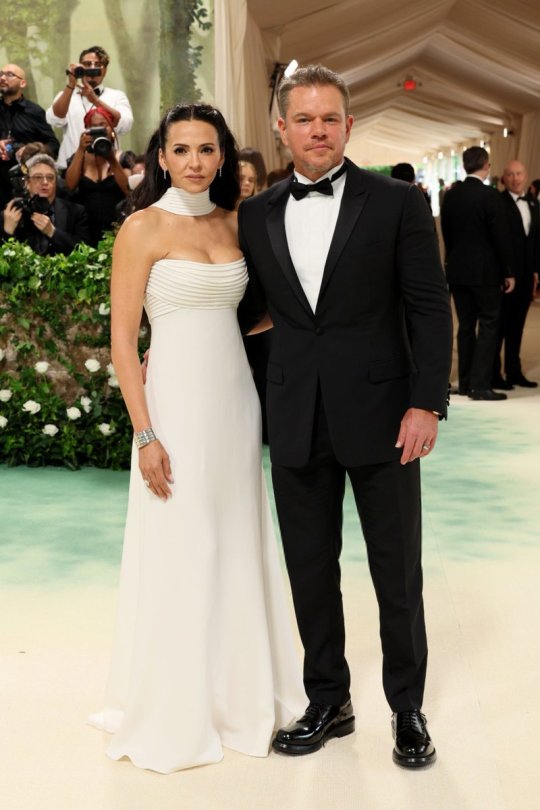

2024's RIPLEY's Tom Ripley (Andrew Scott) with 199's THE TALENTED MR. RIPLEY's Dickie Greenleaf (Jude Law) and Donatella Versace.
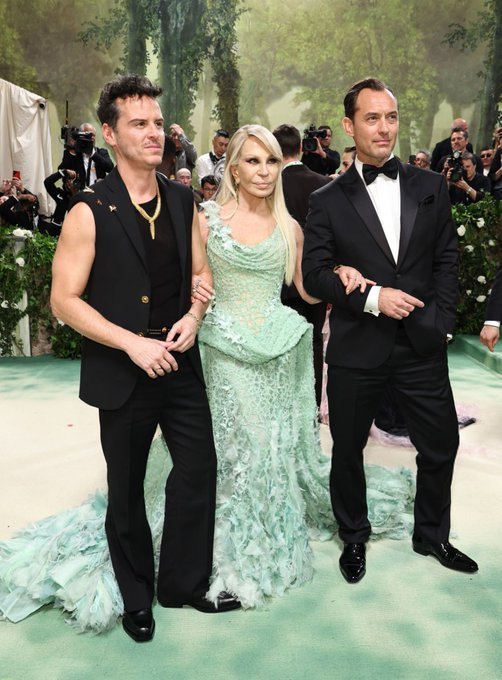
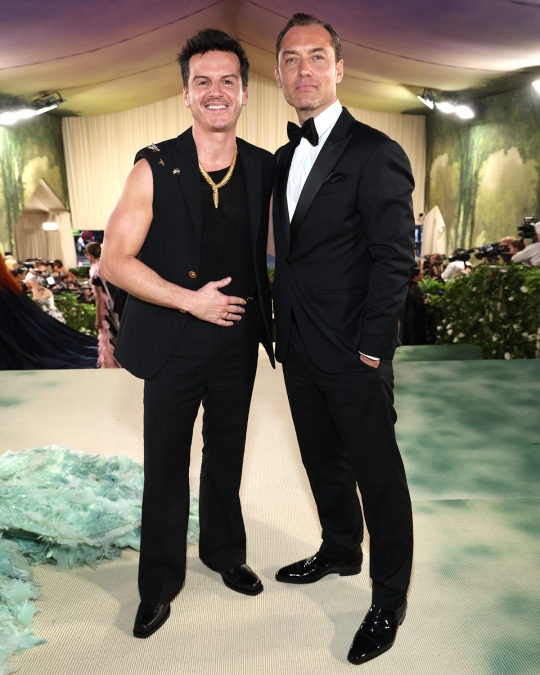
Speaking on merging universes, has anyone introduced Troye Sivan (who played young Wolverine in X-MEN ORIGINS: WOLVERINE) to Hugh Jackman?
Hugh going Met Gala solo after split from wife Deborra-Lee Furness

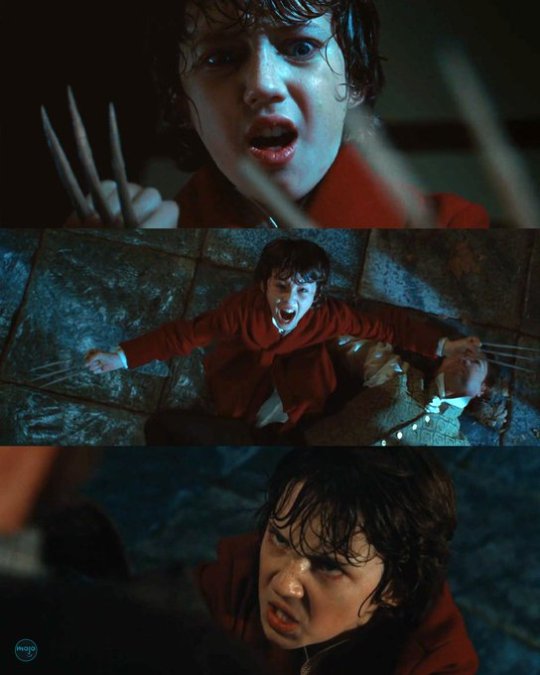
Troye in vintage Prada

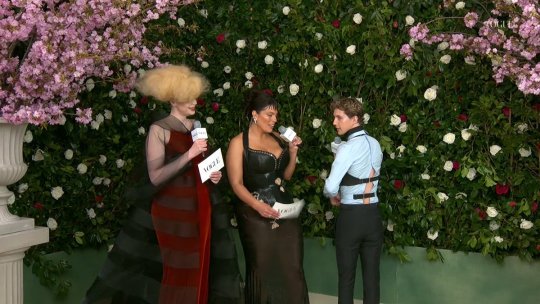
The Wrap Up: Who Wore What
Go on Girls, Give Us Nothing: Team Chloe!
Sienna Miller, Greta Gerwig, Emma Mackey and Zoe Saldana

Wisdom Kaye in custom Robert Wun
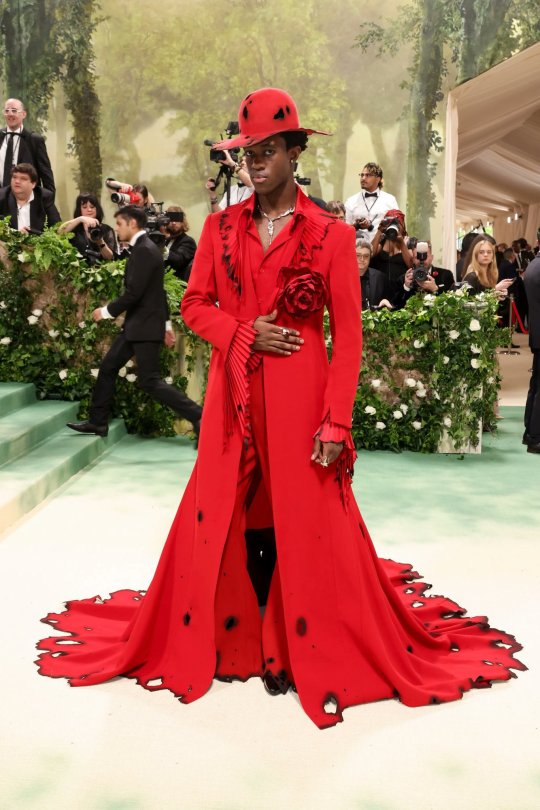
Eddie Redmayne and Hannah Bagshawe in Steve O Smith.
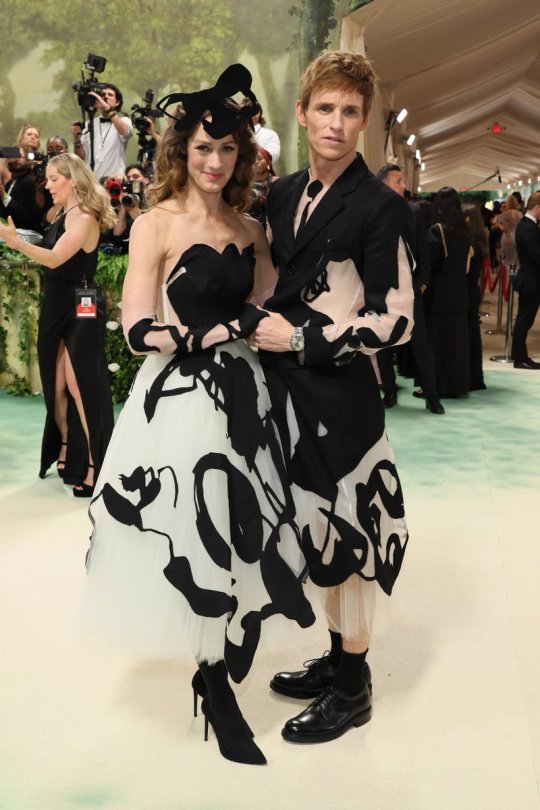
Morgan Spector (Willy Chavarria) and wife Rebecca Hall (in Danielle Frankel)
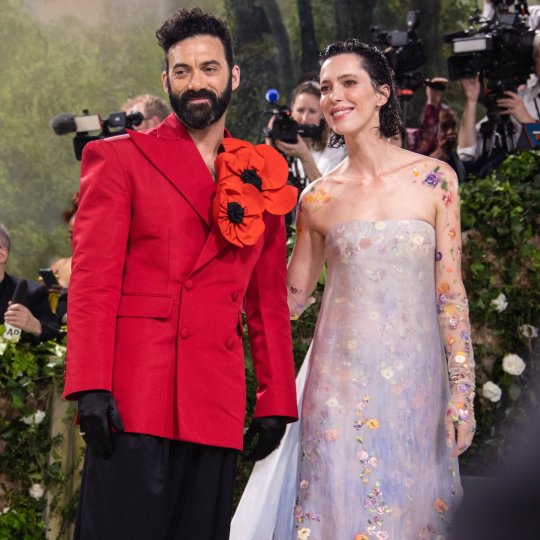
Mindy Kaling in Gaurav Gupta Couture
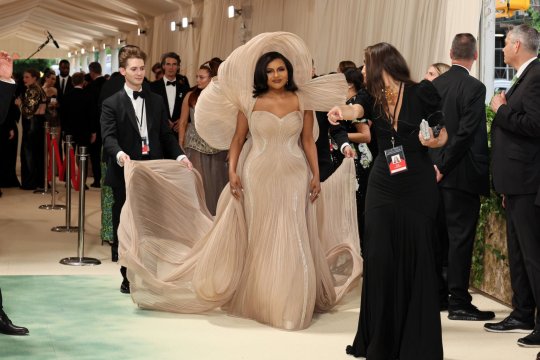

Elle Fanning in Balmain

Olivier Rousteing, Creative Director of Balmain

Lil Nas X in Luar
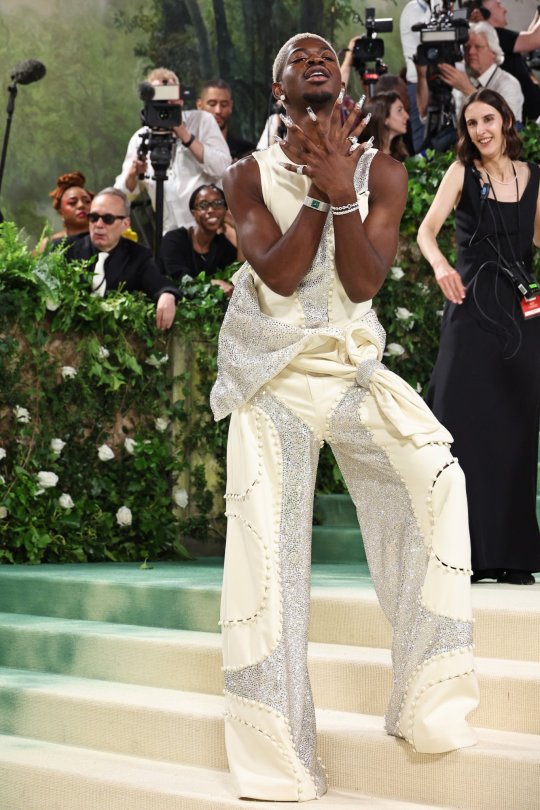
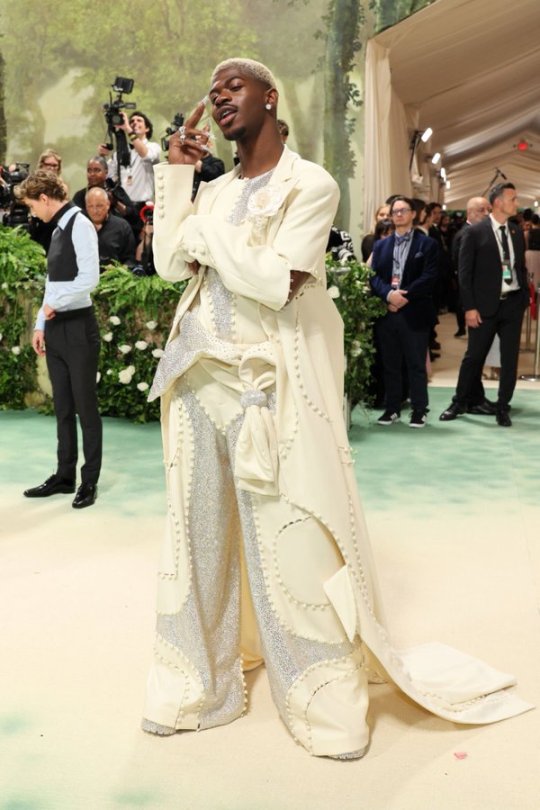
Elizabeth Debicki in Dior
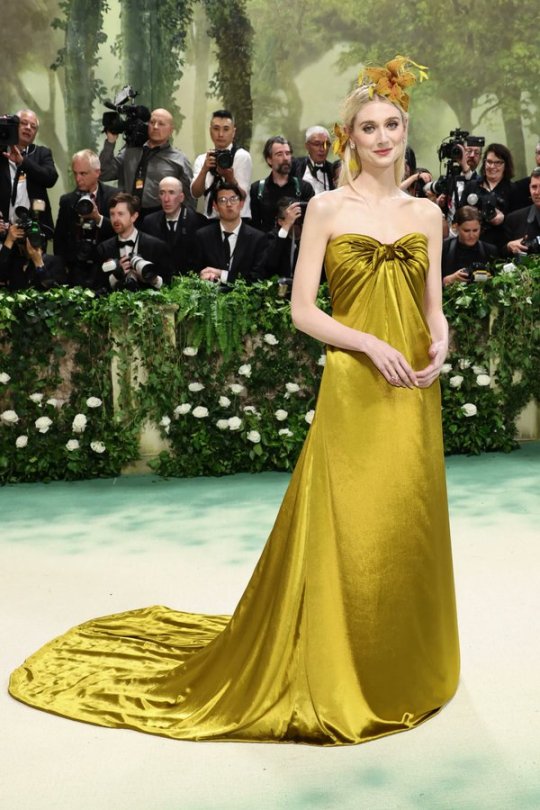
Jaden and Willow Smith

Brie Larson
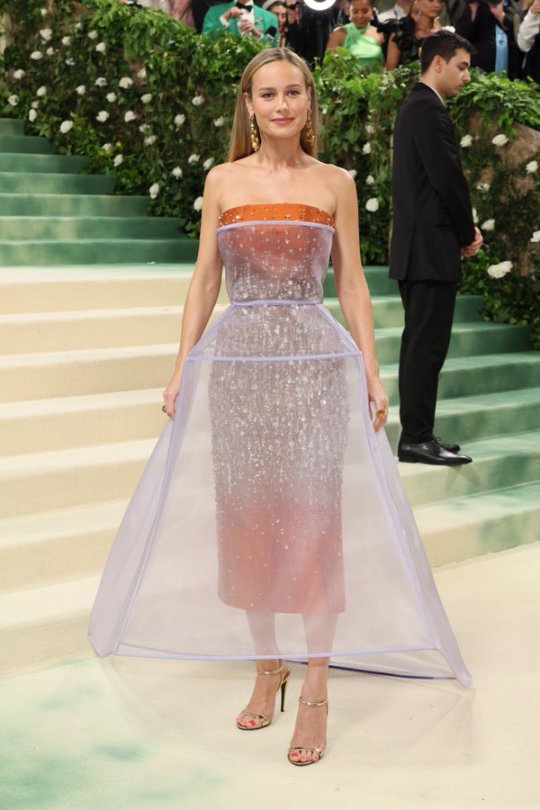
Rita Ora in Tom Ford and Taika Waititi in Marni

Nicki Minaj in Marni
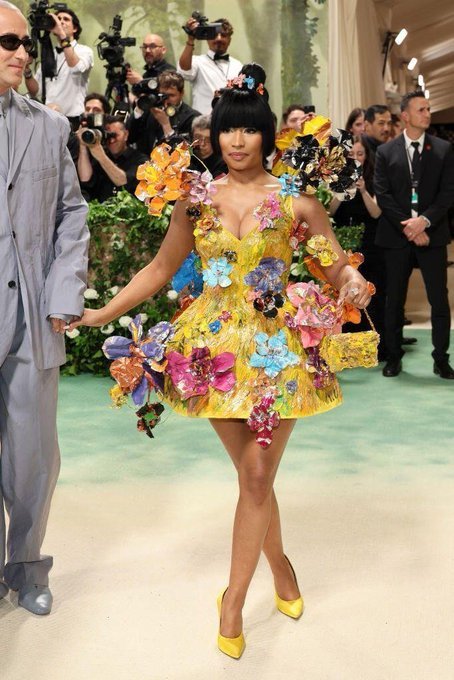
Harris Dickinson in Prada
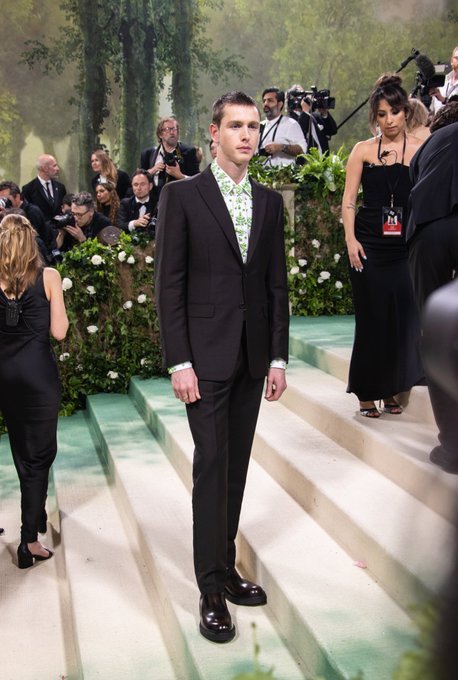
Michael Shannon in Balenciaga
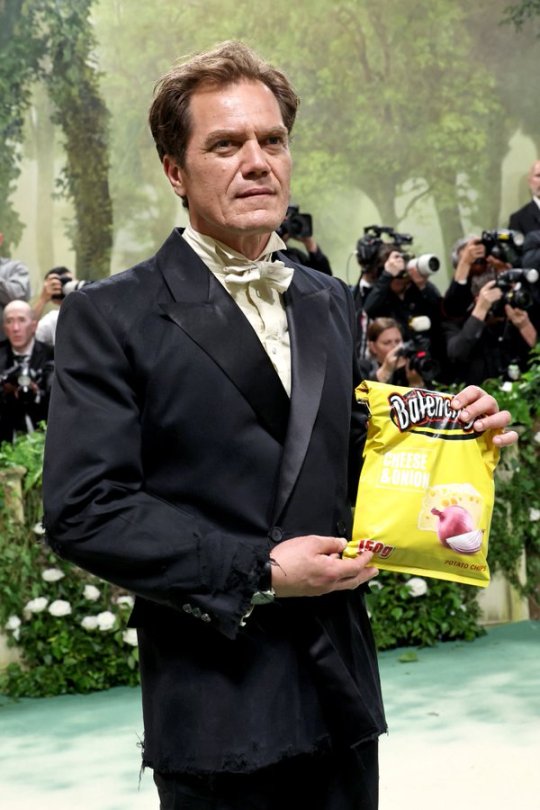
Emily Ratajkowski in Versace
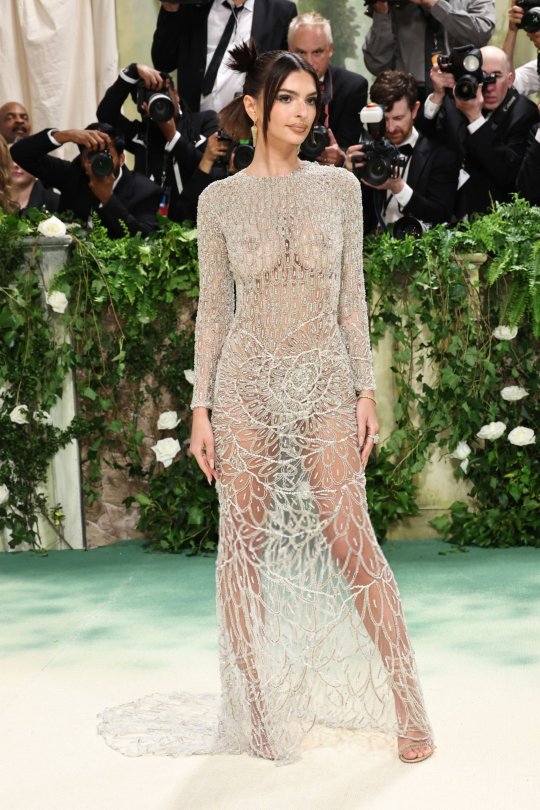
Alexandria Daddario

Ben Platt and Noah Galvin
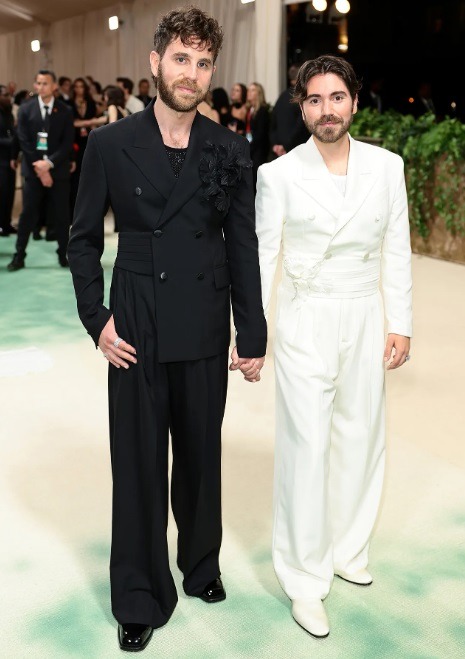
Cardi B

Cardi and Shakira

#met gala 2024#met gala#red carpet fashion#fashion#designers#cardi b#rebecca hall#wisdom kaye#morgan spector#eddie redmayne#noah galvin#ben platt#taika waititi#rita ora#jude law#andrew scott#the talented mr. ripley#ripley#troye sivan#hugh jackman#michael shannon#alexandria daddario#emily ratajkowski#nicki minaj#harris dickinson#brie larson#willow smith#jaden smith#lil nas x#mindy kaling
22 notes
·
View notes
Note
mwf fcs?
some more mwf faceclaims that i'd really like to see around here would be : courtney eaton, ella purnell, adeline rudolph, samantha logan, miya horcher, florence pugh, camila mendes, adria arjona, madison bailey, hannah kepple, liza soberano, lizeth selene, hunter schafer, zion moreno, savannah lee smith, malia pyles, maia reficco, bailee madison, sadie soverall, taylor russell, jaz sinclair, ashleigh murray, rachel zegler, danielle campbell, kaylee kaneshiro, danielle rose russell, kaia gerber, ashley moore, melis sezen, hande ercel, zaria simone, kat mcnamara, cierra ramirez, auli'i cravalho, lana condor, maitreyi ramakrishnan, minnie mills, jane de leon, kathryn bernardo, milly alcock, aisha dee, sasha pieterse, giorgia wingham, blu hunt, anna lambe, marina ruy barbosa, emma mackey, olivia scott welch, kiana madiera, madison iseman, maia mitchell, odeya rush, halston sage, lulu antarisksa, kylie verzosa, emilija baranac, isabella gomez, amber midthunder, simone ashley, humberly gonzalez, phoebe dynevor, kylie bunbury, fiona palomo, alisha boe, amanda arcuri, chelsea clark, antonia gentry, sara waisglass, kathryn newton, gideon aldon, and anya chalotra !

#appless rp#town rp#apartment rp#oc rp#new rp#beach town rp#summer rp#beach rp#summer time rp#original character rp#literate rp#tumblr rp#relaxed rp#mumu rp#rp#palmviewanswered.#mw.
12 notes
·
View notes
Text
Most batteries used in technology like smart watches and electric cars are made with lithium that travels across the world before even getting to manufacturers. But what if nearly half of the lithium used in the U.S. could come from Pennsylvania wastewater? A new analysis using compliance data from the Pennsylvania Department of Environmental Protection suggests that if it could be extracted with complete efficiency, lithium from the wastewater of Marcellus shale gas wells could supply up to 40% of the country's demand. Already, researchers in the lab can extract lithium from water with more than 90% efficiency according to Justin Mackey, a researcher at the National Energy Technology Laboratory and PhD student in the lab of Daniel Bain, associate professor of geology and environmental sciences in the Kenneth P. Dietrich School of Arts and Sciences.
Read more.
12 notes
·
View notes
Text



holidays at the garcia-mackeys
it was too hot in oasis springs for snow, but everyone wore their christmas jumpers for a family picture. they headed out to see alexia in the afternoon and enjoy a family feast.
#ts4#sims 4 legacy#sims 4#strong legacy#strong gen 5#emilio garcia daniels#tristan mackey#liana mackey#lia garcia daniels
12 notes
·
View notes
Text
It all comes down to money. The NCIS: Sydney Season 2 finale, which aired on Friday, April 25, revealed who’s been behind everything all this time, including putting that pacemaker Rankin (Lewis Fitz-Gerald) didn’t need in him, and it was someone close to Mackey (Olivia Swann).
Mackey went way back with Etienne (John Fabry), who was seemingly helping the team with their latest case, only for JD (Todd Lasance) to realize he’s the one who was going to make off with $1.7 billion; he made money building up international aid contracts following chaos in certain regions. Mackey, of course, took him down before he could blow up a plane. But what’s sure to have people talking over hiatus is whoever that woman is who was waiting for Blue (Mavournee Hazel) when she got home. She’d been looking for her. Below, showrunner Morgan O’Neill breaks down the finale and teases what’s ahead in Season 3.
How did you settle on who was behind everything? Were there any other possibilities you scrapped before landing on at Etienne and having it be someone with such a personal connection to Mackey?
Morgan O’Neill: Well, I think you’ve hit the nail on the head there. What we wanted to do was make sure that it wasn’t some sort of boogeyman that descended from the clouds that had no personal connection to any of our team. When we were coming up with the storylines, we wanted to make sure that in peeling back the layers of who did it, we were also peeling back the layers of our characters, of our family. And Mackey seemed the most obvious place to do that. And because she’s such a tough nut to crack and she plays her emotional cards so close to her chest, it just made sense for the one thing that got through her defenses, that it should be the one thing that might ultimately prove itself to be the big bad.
What did you want to do with Mackey and Etienne’s fight? Because that was rough.
Look, here’s the thing. When we sat down to work out what the fight was going to be, we talked about what it would be like to fight someone to the death having just potentially been very intimate the night before. And so we got together with a fight choreographer and we worked out a fight sequence that was kind of bizarrely intimate given what was going on. Because if you think about it, it’s an unusual situation to find yourself in. You’ve opened yourself up emotionally the night before and then suddenly you discovered that the whole thing is an enormous betrayal. And so we designed the fight sequence and then we sat down with Olivia Swann, who plays Mackey, and we said, “So this is how we’re going to do it.” And she said, “Great, I’m going to do it all.” So every single thing you see in that fight sequence is Liv throwing it down. She trained for a month for that fight sequence and she absolutely kicked ass.

Daniel Asher Smith / Paramount+
How is Mackey doing at the end after all that? How has that changed her? Her in the cab … I felt so bad for her.
Yeah, look, that’s the thing, isn’t it? The last two episodes of Season 2 sort of plumbed a really interesting dynamic between she and JD because it was sort of hard to tell whether JD was reacting like he was because he was just hot and bothered and he was suffering from a little bit of mango madness or whether there was something more akin to jealousy that was going on that was fueling him. And as it turns out, he may have had cause to be concerned for Mackey’s choices there.
And so at the end of Episode 10, of the finale, I kind of feel bad for both of them. Mackey’s driving back in the cab on her own. There’s a very awkward encounter at the airport as they leave. And then JD goes back to his mate’s garage where he’s living his best life in a foldout bed surrounded by his mate’s junk. We really wanted to leave that big question mark hanging at the end of the season. These two guys who clearly have a strong affection for one another, certainly a strong professional connection, have really been put through the ringer a little bit, and hopefully like you, the audience feels for that dislocation at the very end.
Speaking of JD in the garage, I was going to ask what is it going to take for him to move out of that garage?
It’s a very good question, Meredith, and one that we will definitely be answering in Season 3. It’s interesting, sometimes in situations like this, certainly in my experience, you got to go to the far ends of the earth a little bit. You really got to break it down before we can start to put things back together again. And I think for JD, he kind of feels like it’s a little penance that he’s paying. He could go out and rent an apartment, do all that stuff, but in the case of my friends whose marriages have broken down, you kind of hold out hope until there is no more hope. And I think the idea of moving out of his mate’s garage might’ve been sort of the final nail in the coffin that said that his marriage is not coming back anytime soon and that he should step out and open a new chapter of his life, and I don’t think he’s quite willing to do that yet. But come Season 3, we might see a different JD.
Yeah, because he’s comfortable — not physically comfortable because you can really be physically comfortable living in a garage, but comfortable emotionally and mentally and where he is in that position, right?
That’s right. And it’s that moment where people look at the necessary rebuilding of a life and they just take a big deep breath and work out exactly if that’s what they’re going to do. And for JD, as I said, he is going to be forced to entertain the reality that his marriage is over and that he’s a single guy and all the things that flow from that.
The woman waiting for Blue when she gets home, what can you say?
Obviously I don’t want to give away too much, but from the expression on Blue’s face, it’s clear that she knows who this woman is and the woman has, as she says, she says, I’ve been looking for you. And all the way through Season 2, as you would know, we’ve been slowly dropping some breadcrumbs about Blue’s really unusual, opaque past. And even if you look at Episode 7, which was the episode with Nova, the singer, when Blue was on her way to that concert, you could tell that she was trying to avoid being photographed and she has no digital footprint, which is strange for a person who works in the type of situation that Blue works in. And so when she got her photo taken with the kid up in Darwin, who snagged that million-dollar fish — which by the way actually happened, but that’s another story — it’s triggered someone to come looking for her now that they know where she lives. And so there’s an element of menace, at least I feel like there’s an element of real menace in who this woman is, and I’m confident that the questions that you’re asking will be answered very early on in Season 3.

Daniel Asher Smith / Paramount+
So what can you say about the relationship between those two and about just the dynamic as well?
Well, I mean it’s more about what we’ve already said in the season leading up to that and the pieces of that jigsaw puzzle. We know a little bit about Blue’s tattoo. We know that it was designed by her brother. We know that they haven’t spoken for a long, long time. We know that she’s got something that she wants Doc [William McInnes] to take a look at. When they get back to Sydney, when they’re fishing up in Darwin, she says, “I’ve got this thing, can you help me out with?” So she’s obviously got a secret that she wants to unburden herself of. And the question I suppose is, will she ever get the chance to do that? Because that woman who has somehow found her and broken into her apartment and is lying in wait, what’s she going to do with Blue at that point? From my perspective, it doesn’t look particularly rosy for Blue. I’d be terrified if I were her. What do you think is going to happen to her?
I don’t know. I’m like, is she her mother? But is that too obvious? Is this a relative? I’m kind of stuck on all possibilities.
Well, look, I hate to be coy, Meredith, but that’s a good place to be, from my perspective. [Laughs]
So the team has really settled into a well-functioning. What can you share about the conversations you’re having about how to keep that going or how to shake that up more going forward?
It’s interesting. The first season was about can we build a family, and then the second season was about how we put as much pressure as we can on that family to see whether the binds will tie. And we’re in production on the third season, as you know, and we’re kind of exploring what is a pretty universal theme, which is that, if you don’t deal with your past, the past will deal with you. And so a lot of the questions you’re asking are thematically linked into Season 3. What does Mackey do with the fallout from Darwin? What does JD do with the breakdown of his marriage? What does Blue do with a strange woman sitting in her living room, having tracked her down, waiting for her? The past coming back to haunt our characters is the central theme of the third season of the show. So you’ve kind of intuitively latched onto where we’re going. I can’t be too specific about it because I don’t want to spoil for anyone, but it’s definitely a case of accepting the reality that you can’t outrun your past and that if you don’t deal with it, it’s going to come back and hit you like a freight train. And in Season 3 it does.
So we’ve talked before about the potential for romance for Mackey and JD and Evie (Tuuli Narkle) and DeShawn (Sean Sagar) and those complicated relationships there. What can you say about both those relationships and the possibility of the show going there for each heading into Season 3?
[Laughs] Look, who knows what emotional possibilities lie ahead. I would say that we find ourselves in a really interesting situation with Mackey and JD, obviously, as we just described. Mackey has exposed herself, revealed herself emotionally, and she’s been kind of punched in the face literally and metaphorically. JD has effectively saved her life, but also revealed that the reason that he was so skeptical of Etienne in the first place may have been equal parts personal and professional. And yet they’re both very, very aware of the fact that if there’s an emotional bond that’s building between them, it’s not something that anyone wants to entertain. They’re work colleagues. They’re heads of an office, which is this blended family between America and Australia, and to go there romantically would risk a whole lot. So there’s a lot of reasons for them not to succumb to any kind of romantic tension. But that being said, that’s me being logical. As we know, our emotions aren’t necessarily always that logical, and so Season 3 will see a fair bit of that tussle between head and heart, I suspect, with Mackey and JD.
With Evie and DeShawn, it’s a different thing. See, I always look at them as brother and sister, and they bicker a little bit like myself with my sisters. I know a lot of people out there see it through a different lens, and that’s cool and who am I to judge? Maybe there is something that’s there. I think the reality is, Tuuli and Sean, who play Evie and DeShawn, are such good friends and their own personal connection bubbles through to the surface so easily that it’s kind of hard not to ship them on some level. Whether anything happens significantly moving forward in Season 3, I really can’t tell you, but I will tell you that there will be, and I don’t think I’m being too coy here, there’s the fly in the ointment that arrives in Season 3 that will really send that relationship into a kind of different realm. So there’s a fly in the ointment that arrives that will potentially upset that beautiful thing that they’ve got going.
Is that a new character?
I can’t really say at this point, but you’ll know when you see it.
Can you say if we’re going to be meeting any significant new characters?
Yeah, there will be a couple of new characters coming along in Season 3. And again, the new characters that will arrive will in a lot of ways further that idea of the past coming back to haunt you, not in any kind of obvious way, but they’ll take our characters down the rabbit hole. And I suppose the question is, will they all make it back?
Are these recurring characters or are you adding a new series regular?
A little bit of both. A little bit from column A, a little bit from column B.
Is there anything else you can tease about Season 3? And there’s always that question of a crossover.
Yeah, look, I was really thrilled the other day to hear the mothership give NCIS: Sydney a shout-out, and we’ve been talking about ways that we can make that work. The tricky thing just from a practical perspective is that we’re 9,000 miles from you guys, but we’re definitely talking about it and trying to work out how that might happen. We would like nothing more than to work out how to cross over with the mothership. My favorite episodes of the show are the crossover episodes, and I know there’s a lot of love for them from the audience in general, so we’re definitely exploring that possibility, let me say.
Yeah, because even the little mentions are great just to hear Mackey’s name on NCIS.
Yeah, it was cool, wasn’t it?
Were there any significant storylines or scenes that you had to scrap from the season for any reason, whether it was just through the other stories that you were telling or due to time since it was only a 10-episode season?
Not really. We had the season planned out pretty well in our heads. I will say that the nature of the storytelling that the NCIS universe affords us is that you want to tell more stories. Obviously you want to go deeper into character and you want to peel back all of the people that we want to spend that hour with every week, and you want to find out more about them. You want to find out what makes them tick. And there’s been so much love shown for Mackey and JD and Evie and DeShawn and Doc and Blue that we’re just desperate to tell more stories and we’re really excited to be back in production for Season 3 and to get the opportunity to do that. We certainly didn’t leave any stories on the floor, but we’ve got a whole lot of stories up our sleeves that we want to tell. There are really interesting backstories behind each of these characters that we’re really looking forward to revealing.
2 notes
·
View notes
Note
Hello! I am very interested in joining, but would like to know if there are any faceclaims you all would really like to see join the rp? There are just so many great faces that I wanted to ask before sending in an application. Thank you!
hi, thank you for your interest! here are some fcs that came to mind! mason gooding, harris dickinson, pedro pascal, oscar isaac, manny montana, rudy pankow, jonathan daviss, andrew garfield, lorenzo zurzolo, arón piper, manny jacinto, evan mock, aaron tveit, thomas doherty, archie renaux, brenton thwaites, casey deidrick, avan jogia, maxence danet fauvel, logan lerman, keith powers, raymond ablack, rahul kohli, andy samberg, joseph quinn, xolo maridueña, tanner buchanan, clayton cardenas, mario casas, bill skarsgard, zethpan smith gneist, bradley cooper, joseph morgan, alberto rosende, emilio sakraya, tom holland, manu rios, luke grimes, kedar williams stirling, regé jean page, andré lamoglia, henry zaga, chay suede, elias kacavas, josh heuston, nico tortorella, felix mallard, jamie dornan, chris wood, justice smith, luka sabbat, alex fitzalan, jeff satur, herman tømmeraas, carloto cotta, ander puig, froy gutierrez, charles michael davis, george sear, darren barnet, jon bernthal, ben barnes, anthony ramos, corey mylchreest, anthony keyvan, sinqua walls, cody christian, eddie redmayne, jaehyun, hugh dancy, michael evans behling, elliot fletcher, emre bey, joe keery, chance perdomo, ross lynch, gavin leatherwood, richard madden, alex aiono, shiloh fernandez, chris evans, chris wood, jacob elordi, danny ramirez, drew starkey, havana rose liu, davika hoorne, lalisa, lulu antariksa, christina hendricks, zion moreno, jennie kim, danielle rose russell, kaylee bryant, anya chalotra, simone ashley, charithra chandran, maia mitchell, cierra ramirez, melissa barrera, hailee steinfeld, diane guerrero, stephanie beatriz, melissa fumero, greta onieogou, maia reficco, alisha boe, paris berelc, camila mendes, bruna marquezine, camila queiroz, anne hathaway, lauren tsai, rachel hilson, inbar lavi, lesley ann brandt, giorgia whigham, antonia gentry, katie douglas, melisa asli pamuk, margot robbie, jenna coleman, halston sage, chelsea clark, brianne howey, cindy kimberly, chloe bennet, halle bailey, sara waisglass, jessica alexander, christian serratos, phoebe tonkin, claire holt, isabella gomez, courtney eaton, madelyn cline, madison bailey, abigail cowen, jessie mei li, blu hunt, auli’i cravalho, anya taylor joy, annie murphy, mila kunis, simary barlas, mimi keene, aimee lou wood, emma mackey, samantha logan, natalia dyer, megan suri, maya hawke, coco jones, jasmine tookes, ana de armas, chase sui wonders, priscilla quintana, maris rascal, keke palmer, angelique boyer, rachel sennott, benedetta porcaroli, valentina zenere, ludovica martino, joey king, fivel stewart, adeline rudolph, natasha liu bordizzo – hope these help!
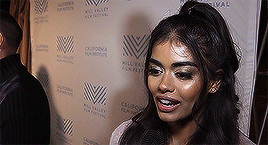
37 notes
·
View notes
Photo


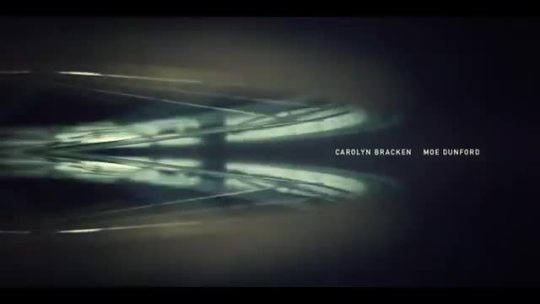





Dublin Murders - BBC One / RTE / Starz - October 14, 2019 - November 5, 2019
Crime Drama (8 episodes)
Running Time: 60 minutes
Stars:
Killian Scott as Rob Reilly
Sarah Greene as Cassie Maddox
Michael D'Arcy as Adam Reilly
Tom Vaughan-Lawlor as Frank Mackey
Eugene O'Hare as (Det.) Quigley
Moe Dunford as Sam O'Neill
Ellie O'Halloran as Jamie Rowan
Niall Jordan as Peter Savage
Ian Kenny as (Gda.) Phelan
Recurring
Conleth Hill as (Superintendent) O'Kelly
Peter McDonald as Jonathan Devlin
Amy Macken as Katy and Jessica Devlin
Leah McNamara as Rosalind Devlin
Jonny Holden as Damien Donnelly
Sam Keeley as Daniel March
Antonio Aakeel as Raphael "Rafe" Hyland
Charlie Kelly as Justin Mannering
Vanessa Emme as Abigail "Abby" Stone
Alexandra Moen as Simone Cameron
Kathy Monahan as Margaret Devlin
Ericka Roe as Alannah Shorey
Florence Ordesh as Mel Royce
Ned Dennehy as pathologist
#Dublin Murders#TV#BBC One#RTE#Starz#Crime Drama#2000's#Killian Scott#Sarah Greene#Michael D'Arcy#Tom Vaughan-Lawlor#Eugene O'Hare#Moe Dunford#Ellie O'Halloran#Nial Jordan#Ian Kenny#Conleth Hill
2 notes
·
View notes
Note
oi moderação, tudo bem? eu nunca joguei rpg de fantasia antes, mas achei esse daqui e gostei muito. pensei em aplicar, vocês tem sugestões de personagens ou fcs que gostariam de ver por aqui?
Oi, fadinha! Estamos ótimas, obrigada por perguntar. Nós já fizemos alguns prompts de personagens por aqui, alguns soltos e outros até com indicações de fcs e histórias prévias, é só acessar esse link para redirecionar. Vou tentar dar algumas sugestões de fcs diferentes, mas fica nesse link outras dicas que já demos e indico esse blog com fcs 'dentro do tema'.
MWF: Ella Purnell, Emma Mackey, Saoirse Ronan, Danielle Perkins, Danielle Rose Russell, Jessica Green, Andrea Bang, Brianna Hildebrand, Claudia Jessie, Emilia Clarke, Lindsey Morgan, Phoene Dynevor, Savannah La Rain, Wang Herun, Alicia Agneson, Marina Moschen, Anya Chalotra.
MWM: Ismael Cruz Córdova, Charlie Vickers, Matt Smith, Freddie Fox, Jack Lowden, Jeffrey Dean Morgan, Jensen Ackles, Miguel Bernadeau, Jonathan Bailey, Richard Madden, Thimothee Chalamet, Dylan Wang, Manny Jacinto, Leo Sutter, Brenton Thwaites, Calahan Skogman.
MWNB: Jessie Mei Li, Emma D'Arcy, Indya Moore, Liv Hewson.

2 notes
·
View notes